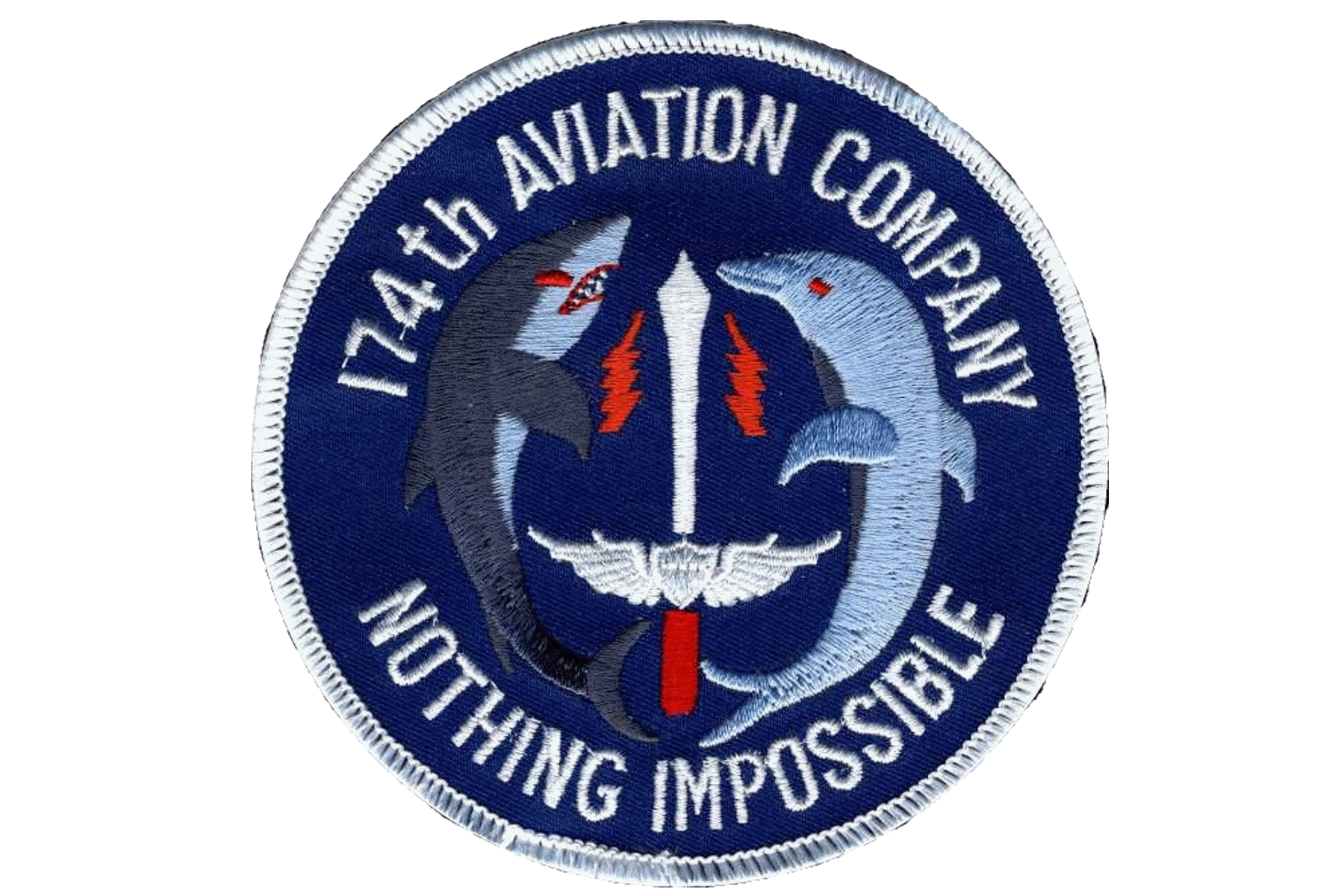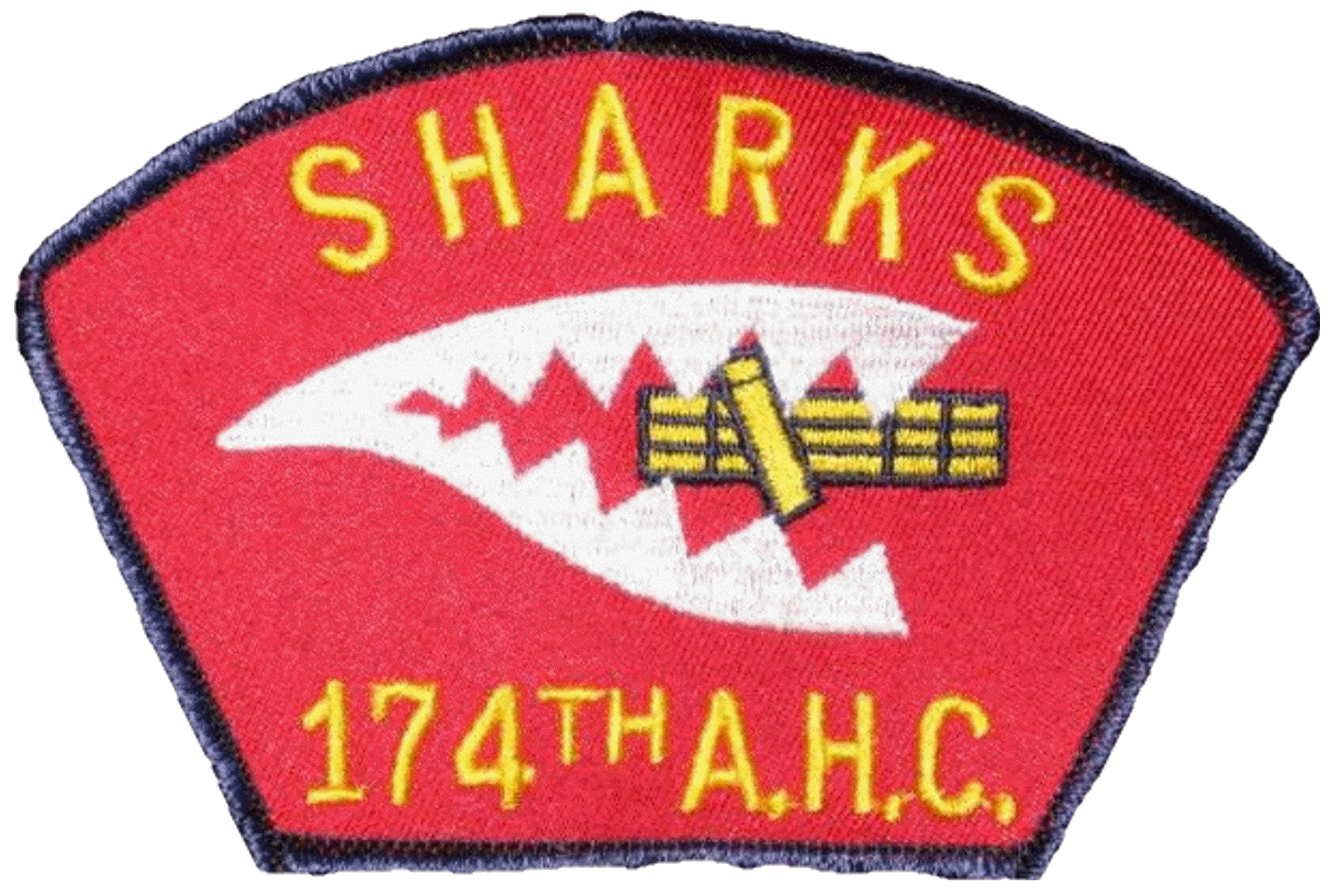174th Assault
Helicopter
Company
DOLPHINS & SHARKS
Biography ofA. Dale Parker |
Childhood & The Early Years
I was born 20 December 1938 and
raised near Alexandria, LA. I guess from the beginning I was a bit of a wild child. We raised cattle and
farmed. My Dad was a WWII Marine Vet of the Island campaigns. He would never talk about his
experiences, but they had a profound affect on him. He was among the first boots on the ground
in Nagasaki, Japan after the bomb was dropped. He did open up a bit about that part and it wasn't
good. He always said to hope and pray it never happens here. He always respected the Japanese
people.
He and my mother were pretty strict in some ways, but not overly protective. We could do things
that kids growing up today can only dream of. I started "breaking" horses at a young age. From there
I went to competing in small rodeos while in high school.
I was always in trouble for fighting and skipping school. From the time I could do anything- I had
chores to do. In the summer it was all work except for Saturday and Sunday. Saturday was "go to
town" day. Mom and Dad would take my sister and me to a movie and drop us off while they shopped.
The movie was a double feature usually Roy Rogers or Gene Autry types. There was always the Star
Spangle Banner followed by a news reel, and then some type of serial first and then the main
features. It was a good "baby sitter." No TV then, I never saw a TV until I was stationed in California
in the Navy.
My spending money I earned by picking cotton (no cotton picking machines in those days) and
hauling pulp wood (no chain saws). Everything was done by hand. I can remember having dates
and going to a drive-in movie, buying popcorn and cokes and then after the movie going to the
local hamburger joint and having real burgers and fries all on less than $7 for two people. This
was always on Saturday night. All-in-all life was good. We didn't have a lot of extras but we always
had clothes to wear and enough to eat. I finally rebelled and joined the Navy in December 1955.

December 28, 1955, 8 days after my seventeenth birthday, I was sworn in to the US
Navy in New Orleans. La. and was on my way to San Diego,CA. for boot camp. My gesture of
defiance to my Dad (he tried to get me to go to the Marines). At the time, I didn't know the Marine
boot camp was only across an inlet about 100 yards wide from the Navy's. It was a rude awakening.
Everything the Marines did for PT (physical training) we had to do too. Really, it was easy for me because I was used
to physical work. I actually gained about 25 pounds. I hoped to get into the Seabees, but the "powers
to be" saw fit to send me to Aviation School in Norman, OK. That was OK with me, for I had been
around crop dusters. There was a small airstrip close to my home that had some biplanes. I was a
"gofer" and they let me touch them sometimes, so I knew what an airplane was.
After Basic, I chose not to go to advanced school, and was sent to NAS Miramar which was just outside
of San Diego. I was assigned to VFP61, which was a Photo Squadron with F2H Banshees, F9F
Cougars, TV2s (Navy T-33), and two SNB5s (Navy C-45). How it happened, I don't know, but I was
assigned to the C-45s as a Crew Chief. I was getting flight pay and really "got into" flying. There were
only two EM in the squadron on flight status. They even sent me to Combat Air Crewman School.
That was rougher than Boot Camp. The bad guys were all WWII and Korean War Marine Vets and
they hated the Navy. It is the roughest course I have taken, but I managed to get through it. About
the time I got back to the Squadron, it was in the process of reconfiguring. The C-45s were "going,"
and that meant I would probably lose flight pay.
Somehow, I was sent to another school
for training in the altitude chamber and ejection seat. This allowed me to fly in the T-33. I only got a
ride a couple times and it was scary. Finally, I ended up a crew chief on the F9F. The unit only
deployed Detachments on Aircraft Carriers.
In 1957, I was selected for a deploying detachment on the USS Kearsarge for 6
months. We made stops in Hawaii, Philippines, Japan, Okinawa, Hong Kong, and several other
ports. This started my fascination with Asia which I have never gotten over. One of the highlights
of the cruise was making port in Kobe, Japan. The ship could not maneuver under its own power
to dock. At that time the Navy used a pinwheel maneuver. This entailed lining both sides of the
flight deck with aircraft, Preferably A1Es, because the prop blast worked better than jet blast, The
aircraft would be started and the crewmember in the cockpit would increase or decrease throttle and
actually turn the ship using the aircraft engines. When it was positioned, the aircraft would push it
to the dock. It was an intricate maneuver and Kobe was the only place we used it.
When
we left Kobe, we went to the Formosa Straits. Things got a little "hairy" there. China and Formosa
were "rattling sabers" and China had massed a large force on their side of the Straits. We were
patrolling the straits to keep the peace. We were the only Naval force in the area. We patrolled up
and down between them. There were two armed fighters in the air 24 hours a day, with two manned
 on the catapults and two on standby behind the Cats. The ship was on battle stations. The best way
to explain it is- we were ready for war and werenít playing. I think we were just "bait", because we
wouldnít have lasted long. We patrolled for about a week. It was like looking at the China coast one day
and Taiwan the next.
on the catapults and two on standby behind the Cats. The ship was on battle stations. The best way
to explain it is- we were ready for war and werenít playing. I think we were just "bait", because we
wouldnít have lasted long. We patrolled for about a week. It was like looking at the China coast one day
and Taiwan the next.
It finally blew over, and we were off to Hong Kong. We were there
a few days. Everyone took advantage of the shops to buy clothes. Everything was dirt cheap and
tailor-made. This included boots. I got a nice cashmere jacket, a set of dress whites and kangaroo
skin boots for about twenty dollars. I have never gotten anything that fit as good or lasted as long.
Itís probably not like that now. Life on the ship was crowded and back then they were hot. Water
rationing was a way of life. The food was great. When we got back to Miramar I was assigned to the
engine shop on night shift. We actually worked steady hours and didnít pull any guard or other
details. I finally made E4, which is a petty officer, and was made a crew leader, Right after my
promotion; I grabbed a broom to help my crew sweep up before getting off. Boy, did I get a "butt
chewing." The Chief in charge of the night crew let me know that my hands did not fit a broom or a
swab anymore. I was a Petty Officer and was expected to act like one.
Pretty soon, I was
told to put in a "dream sheet." Hawaii was the last place I wanted to go, so I asked for it- knowing
I wouldnít get it. It worked, and I got my third choice. Japan was my second and Okinawa third.
When I got GMGRU 1 (Guided Missile), I was the 19th man. We had two F9F5 and one FPF2 Panthers.
These were Korean War relics that were piloted drones. Our mission was to supply "target drones"
for Regulus missile equipped submarines (whenever they simulated a launch). One plane would
be the drone and the other the chase plane, with the third a standby. We rarely had a mission. We
were directly under the Commander in Chief Pacific Fleet and stationed at Naha Air Force Base.
The other Navy Unit at Naha had F6F Hellcats and B-26s. Their mission was to tow sleeves for
ships gunnery practice. No one knew what to do with us, so we did whatever we wanted. Our
orders were from high enough that no one wanted to have anything to do with us. The first few
days of the month, the pilots got their minimums, and we started planning the monthly party at
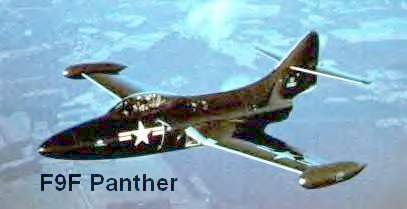 an isolated teahouse on the other side of the island. The parties would last two or three days.
an isolated teahouse on the other side of the island. The parties would last two or three days.
Okinawa was administered by the Navy. It hadnít been given back to the Japanese at that time.
We had a boat that was docked in Naha Harbor. It had come out of the salvage yard under "some
made-up reason" for having it. To keep it in the harbor, it was supposed to be manned continuously
and the crew was entitled to subsistence rations. Everyone, not married, was assigned to the boat
as a crew member. That was about $30 a month extra. In those days, that was a lot of money. We
all shacked up in town. When I leave this world, I will be in hell, because Iíve spent my time in heaven.
Okinawa in those days was paradise.
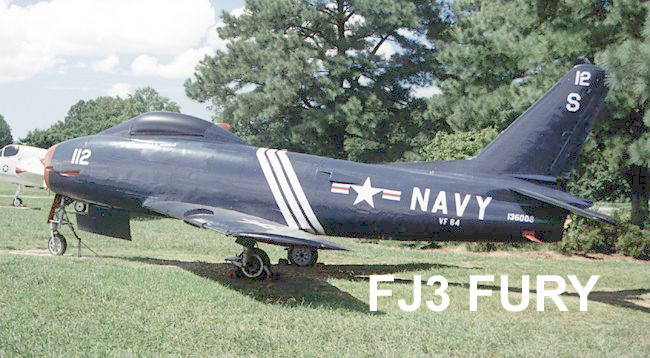
After I was in Okinawa a few months,
our detachment doubled in size aircraft wise. We got three FJ3s. This was still a Korean
War relic, but still flown as fighters. They were to be used as chase planes on our missions,
which were still rare. When they arrived, the decision to retire our F9F2 was made. This was
the last operational one in the Navy. I was picked to take it to Japan for its trip to the bone yard. We
preserved it, and loaded it onto a LST that was crewed by a Japanese civilian crew. I was given a
stateroom and a few cases of C Rations for the trip. When we left Okinawa, I found the only ones
that could speak English were the Captain and the First Mate. The Captain asked me if I liked
oriental food. Hell, by this time I was "native." The crew got my Cs and I ate the same food they did.
We hit some bad weather after a couple of days, and the CPT asked if I could unfold the
wings. That was no problem. We were three days late getting to Japan. When I tried to turn the
plane in, they refused to take it. The tail pipe cover and a couple of other small items were missing.
I just walked out and left it. We never heard anything more about it. Below right, is a photo of
LTG Peck Haynes and me standing next to this F9F2.
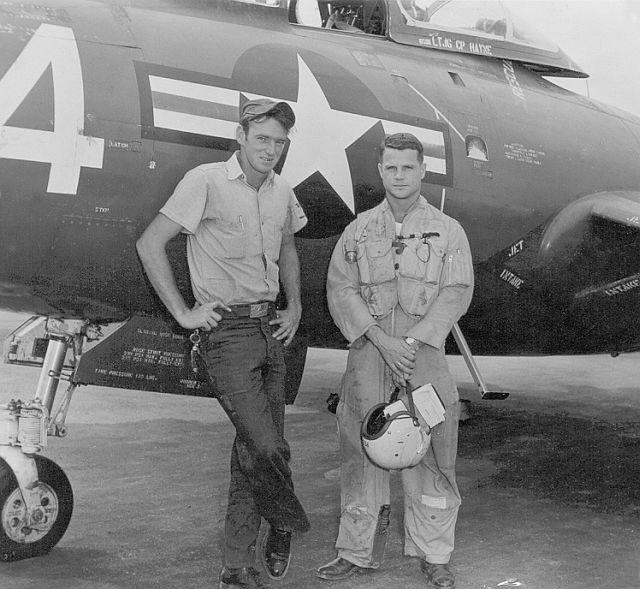
When I got back to
Okinawa, I was assigned one of the FJs. This was a "Cadillac" compared to the F9s. Someone
made the decision to send two FJs to, what was still, Formosa to play games with their Air Force.
They were still flying F-86s and F-84s. My bird had a "flame-out," and landed on a runway under
construction next to a small town. We found out that an engine had to be shipped from the states.
We had to stay until it got there and then change it out. Another bunch of Ks to eat and a handful
of money. TDY (temporary duty) pays at $9 a day.
There was a small hotel in the town.
The Ks we traded
and we lived off the land.
The most we spent was about $4 a day and we lived like kings. The civilians treated us like family.
After about 30 days, the engine arrived and we left. There was a big party and a lot of crying. They
hated for us to go.
It wasnít long after we got back to Okinawa and somehow, an Air
Force pilot got to fly one of the FJs. He managed to crash it on the runway and walk away. I think
our parent unit, which was in NAS Barbers Point, Hawaii, figured out that we were having too much
fun. I had been in Okinawa about 18 months, and was one of the first to leave. To fly out, we had
to go to Kadena AFB. When I got to Kadena, there were no flights out, and I was told to check back
in a couple days, so I went back to my "girl friends." About a month later I got out of Okinawa and on
to Hawaii.
I hated Hawaii. Being "under the flagpole" was not fun. Everything was
chickenshit. There was really nothing to do when I was off. After I was there about a month,
I finally got up enough nerve to go to Honolulu. There was a pair of military police everywhere
you looked. They had a reputation for roughing people up. I decided to get away from downtown,
and ended up in a small Japanese bar, with no Americans around. They treated me like a long
lost family member. I couldnít buy anything. It was all free. The rest of the time I was in Hawaii,
I spent my Ďoff timeí there. A lot of people wanted to know where I went, but I wouldnít tell them.
When I left for the states, there was a big Ďgoing away partyí and I was the only American there.
If the Navy had left me in Okinawa, I would have never gotten out. Sending me to Hawaii pushed
me out. In Nov 1959 I was a civilian again.
I got out of the Navy in November 1959 and went back home. Jobs were hard to come by and I ended
up working for the state veterinarian in one of the local livestock sales barns. That was hard dirty
work. Someone was always getting hurt. After the sale was over I would drive a cattle truck hauling
to slaughter houses all over the area. It was a six and sometimes seven day a week job. I believe
I was making twenty or twenty-five dollars a day. There was no overtime. Work all day and honky-tonk
all night. I was running with a pretty rough crowd
I decided once to try to go to work with Rapides Parish Sheriffís Dept. One of my dadís good friends
worked there and he helped me. I actually had the job, and the friend told me to be real sure that was
what I wanted to do. After thinking about it, I changed my mind. How could I arrest the people I was
partying with? The job in the stock yards petered out and I drifted to Atlanta, Georgia. I worked in a
gas station for a while but decided the big city was no place for this country boy. I went back home
to no job. I wasnít back long, and woke up one morning realizing I was going no where fast, so in
June 1960 I joined the Army. At least I was going to get "three hots and a cot."
I went into the Army as a PFC (1959) and was sent to Ft Jackson, SC. When I got there,
I was informed I did not have to go through Basic Training. That was a welcome surprise. There was
an ex-marine in the reception company, and because of our prior service, we were put in charge of
the recruits. This was like turning a kid loose in a candy store. We could "dish out" what we had
gone through a few years earlier. Boy! Were we in for a surprise? It was a "kinder/gentler" time. We
did manage to teach them their right from their left, and how to spit shine boots. After the CO called
us in and told us we could not be so rough on them, he told us we were doing a good job and asked
us to stay there, and he would promote us. We said no thanks.
I donít know whatever
happened to the Marine, but I went to Ft Bragg to an aviation unit (donít remember which one, but
they had H-13s, H-19s, H-34s, l-19s and L- 20s). I decided to become Airborne, so went to Jump
School (parachutes). It was a good move, but at the time I didnít know it. After getting back to the unit, they
found out I could drive trucks, so I was assigned a brand new 5 ton tractor trailer. At this time,
Army Aviation was still in its toddler stage. It was especially true in the airborne units. Planes
were made to jump out of not to fly in. I ended up driving all over the East coast. I was TDY (temporary duty); a
lot hauling every thing from ammo to parts. We were supposed to drive 250 miles a day. There
werenít interstates criss crossing the country then. People in the small towns treated us like
royalty. If we stopped overnight, we almost always were taken in to their home and fed and
given a place to stay. Away from the military towns everyone loved the Army then. That assignment
lasted for a year and then I got orders for Germany.

In 1961, I was in the Third Armored Division in Hanau, Germany. I believe the unit was E Company
122 Maint. Bn. Once again, the aircraft we had were H-13s, H-19s, H-34s. L-19s, L-20s, and one "Otter". No
one really knew how to get the most capability out of the individual aircraft. They were all so old
that availability was a constant problem. I was working on the bird dogs and H-13s mostly. No
one liked the H-19s. The H-34s were really good aircraft but they required a lot of TLC. I got all
the flight time I wanted and loved it.

CW3 Pete Foster always let me fly. I
was in one
of the H-13s with him when he decided to play tag with a big hawk. I ended up with the hawk
and a lot of Plexiglas in my lap. I forget the story we told, but it must have been good, because
we never heard anymore about it. I remember flying convoy cover in a "Bird Dog." We had planned
to land on the road, when the convoy made a rest stop to refuel. Something happened, and we
ran out of fuel and made an emergency landing on the road. The convoy commander sent a jeep
to us with 5 gallon can of mogas. I poured the mogas in it and we were off again. We spent a lot
of time in the field making the German farmers rich. They charged for every rut and every scratch
on a tree.
I was in Germany about a year and a half, when it seemed like overnight the
H-19s were gone and we got "A" model "Hueys (UH-1A)." Damn- they were cute- with a little bitty
engine that didnít leak oil and smoke. They were quiet. The only immediate problem was having
to send everyone to school to learn to work on them. I was selected to go to the engine school,
because we were scheduled to get some Mohawks too, and I was working on both Rotary and
Fixed wing at the time. And the engines were similar plus my Navy experience with Jets. From
this time on, I was mostly working on the Hueys and Mohawks. I loved to fly in the Mohawk. The
things it would do were an adrenaline rush. I was also driving a truck allot, hauling not only
aircraft parts, but tank parts too. It was along this time, I had a "run in" with a Cpt.. I was sent to
another unit, to get a special tool for something, and Cpt Merrill Bounds was in charge of the
tool shop. I had been warned to stay away from him, but I ran into him anyway. Before it was
over, we ended up in a hell of a cuss fight. I left without the tool and he called my CO, Cpt Tommy
Mansfield, and wanted me hung. Luckily, Cpt Mansfield took my side. It wasnít his first dealing
with Cpt Bounds. I ran into Bounds more over the years and we got to be good friends.
On one of our field problems; I had flown into one of the field strips with a Lt Cloud in an
L20. He was a good pilot. After he dropped me and another passenger off, he picked up another
passenger on a quick turnaround. He was taking off, downwind and down a slight hill, when
I glanced at him. I noticed his flaps were up, and the tree line was coming up. He was trying
to pull up and a couple of us started running towards the Aircraft when it went in to the trees.
When we got to it, we could get the passenger out, but Lt Cloud was pinned in by the engine
and he was slumped over the yoke. We tried to tear the cockpit apart with our hands, when
someone started yelling at us that there was a fire. We looked at Lt Cloud again, and it was
obvious he was dead. We got away before it exploded. The remains fit in a Huey tail pipe
cover.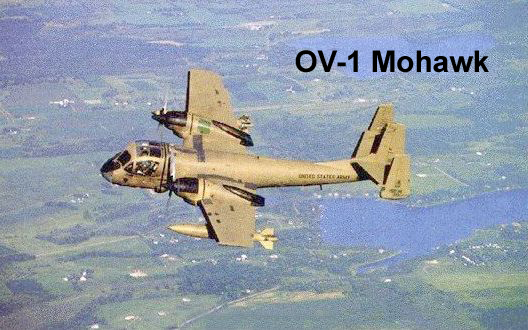 That was my first experience with a fatality in an aircraft crash. The next
one was a couple months later, when a Mohawk was taking off, with just the pilot, when
the port engine quit. It went into a left bank and the pilot ejected before it hit the ground.
It threw him away from the aircraft and the chute deployed, but he was parallel to the ground
about 10 feet up. Before the dust settled, a farmer was yelling who was going to pay for his
beets. He didnít know how close he came to joining the pilot. Cooler heads prevailed.
That was my first experience with a fatality in an aircraft crash. The next
one was a couple months later, when a Mohawk was taking off, with just the pilot, when
the port engine quit. It went into a left bank and the pilot ejected before it hit the ground.
It threw him away from the aircraft and the chute deployed, but he was parallel to the ground
about 10 feet up. Before the dust settled, a farmer was yelling who was going to pay for his
beets. He didnít know how close he came to joining the pilot. Cooler heads prevailed.
I was getting enough of Germany by then. Graf, in the winter with all the snow and ice and Vilsek,
with all the heat and dust in the summer. And about three or four months a year living in tents.
Little did I know what was in store. I even took the Special Forces qualification test trying to get
out of Germany early. I passed the test with flying colors, but an Angel was looking out for me
again. I didnít know it at the time. About this time, if you knew how to spell airplane and helicopter,
it was a safe bet you were going to the 11th Air Assault in Ft. Benning. I decided to beat the Army
system so I asked to go to the 11th Air Assault, thinking they would send me somewhere else. I
got what I asked for.
I believe it was May or June 1964 when I arrived at Ft. Benning. There were Aircraft of
every description everywhere swarming around like hornets. It was impressive. It was here I was
introduced to the "B" and "D" model UH-1. There were even some H-37s and H-34s. My initial
assignment was The 131st Aerial Weapons Company. This was later to become Delta Company
227th Assault Helicopter Bn. We had B Model gun ships with the flex guns. There was a lot of flying
and gunnery practice. We flew day and night. It was hectic. Air mobile tactics were being developed.
After partially getting our act together, we went into the Carolinas to take on the 82nd in the first
really big test of Air Mobility. Everyone realized we part of the wave of the future, as far as military
tactics went. We were also carrying on the tradition of the Airborne, since we were derived from
the 11th Airborne Division. We were really fired up, and the rivalry between the two divisions added
fuel to the fire. We whipped the 82nd all over the Carolinas and proved that Air Mobile tactics were
effective beyond anyoneís wildest dreams. We also learned the need for a lot of improvement with
the Aircraft. The engines ingestion of the Carolina sand was devastating to the compressor blades.
Compressor stalls constantly plagued us. We still had some aircraft with T53L5 and L9 engines.
They were woefully under powered. The D models had a 44ft rotor system and that coupled with
the heat and loss of power because of erosion they were weak. After "Air Assault 2" the first thing
they did was ground all the Hueys, and split the compressor case to inspect the compressors. I
was transferred to a field maintenance company that was tasked to split the compressors on 400+
Hueys. Lycoming "Reps" performed the inspection and replaced the blades as necessary. I believe
it was at this time, all the L5 and L9 engines were replaced with L9A and L11 engines. I was an E5 by
then, with a secondary MOS of 681. I was a Platoon Sgt. and I had a bunch of men under me. I was
working 14 to 18 hours a day/ seven days a week. We still had to do all the routine Army things like
KP, CQ, and Guard duty plus training. It was decided everything had to be modified with the particle
separators, so all the aircraft that we had released, were recalled. We were tasked to put particle
separators on all of them. We finally completed that task.
I was hoping to go back to
my old unit or any flight company (preferably a Gun Company or a Cavalry Troop). Alas, it was not
to be. The 11th colors were retired, and we became the 1st Cavalry Division Airmobile. At about the
same time, there was a change of command and Major Merrill Bounds became the Commander.
When we saw each other, the sparks flew. Another task came down to the company. We were the
unit chosen to modify every "D" model from a 44 ft rotor system to a 48 foot system. This entailed
changing head and blades and putting a donut in the tail boom with a short section of tail rotor
drive shaft and bearings. I asked Major Bounds to let me transfer out, and he told me "hell no". He
was the type of person that made the ground shake when he walked. Everyone, officer and
enlisted, were scared to death of him. He remembered our "run-in" in Germany. I figured my days
in the Army were numbered. There was a severe shortage of NCOs, and I was in charge of the entire
maintenance operation. Again, we were working day and night with an added sense of urgency.
The rumor was going around that, as soon as we completed the modifications, we were on the way
to Vietnam.
I felt like the world was on my shoulders. It was a hell of a responsibility for
an E-5. Plus, I had to keep Major Bounds off everyoneís back (even if it meant I had to make myself
the target of his ranting and raving). Finally the straw came that Ďbroke the camels backí. He had
told me he wanted some signs made by the sheet metal shop. He asked me when I could have
them done. Just to get him off my back, I gave him a time line of about a week. He left. A week
passed, and I heard him in the sheet metal shop yelling and cursing. I dropped what I was doing,
and ran into the shop to see what was wrong. He was cursing and wanting to know where his
signs were. I was totally exhausted and I really "lost it." I told him what he could do with his signs
and if he wanted to yell at anyone, then yell at me but leave my people alone. I was matching him
yell for yell. All of a sudden he got a grin on his face. I thought that my military career was over, but
at this point I didnít care anymore. He told me to get out of his company area right now and he
would see me the next day in his office. I knew it was all over, so I went home and had a few drinks.
The next morning I was in his office. He asked if I had a good nights sleep. I was taken aback by
his tone of voice and his actions. I told him "yes sir." He then handed me a letter of commendation,
and told me to take a three day pass. I walked out shaking my head. When I went back to work,
everyone looked at me like I was a ghost. That was the last cross word I ever had with Major Bounds.
It wasnít long after that, he was "gone" (but our paths would cross again).
We finally finished our task with the rotor systems. They had a Company "muster"
one day, and they took us to the firing ranges. This was our day of training on the M-16, and we were
told the M-14s were gone. The signs were ominous. One of the Hueys that we had worked on took
off on a test flight and crashed on the ramp. One other man and I grabbed one of the big wheeled
fire extinguishers on the ramp and started running toward it the aircraft. It was lying upside down
with the engine running. The crew got out and were running away from it. I heard a bunch of
popping and rattling behind us with a siren wailing. I was scared we were going to get run over,
so I looked over my shoulder and saw a fire truck, coughing and spitting, running slower than we
were. We got to the wreck and I crawled in it and shut the engine down, and was outside laughing
when the fire truck finally got there. I think they were a little embarrassed. It is hard for even me to
believe, but some of the powers that be, gave me "run up" orders for the Huey. Of Course, in Germany
I was on "run up" and "taxi" orders for fixed wing.
By now, we were loading up on officers
and NCOs, so I was reverted back to an E5 job. Major Bounds was still there, and would not release
me. We were now C co. 15th TC BN. The orders came down to dye all our underwear and towels
green. I had no idea how many shades of green there were. Then, in June 1965 we made a "top
secret" (what a joke) move to Jacksonville, FL to board the USS Kula Gulf. I donít recall how many
helicopters we had on board, but there were supposed to be maintenance and crews to assemble
them and fly them off. The ship was not in good condition. General Kinnard inspected the ship, and
made the decision, there would only be enough of us left aboard to take care of the aircraft en route.
All the pilots and crews were taken off, leaving a small bunch of us to make the voyage. The food
and supplies were left on board. We ate like kings on the way over, and had plenty of room with
almost no restrictions. Those that went on other ships were not so lucky. We actually got a lot of
target practice off the fan tail of the ship. After a couple of weeks, it was getting boring. We still had
no idea where we were going.. Anyone in the 11th, was encouraged to make suggestions anytime.
If you thought it would work- try it.
The first thing
to hit everyone, when we anchored in Qui Nhon (July 1965), was the heat and stink.
The work started. Four photos from about that time, are below. The top two photos are "at sea"
and the bottom two are in Qui Nhon Bay (Notice the bottom right photo. A brave villager fisherman
coming
out to see the ship).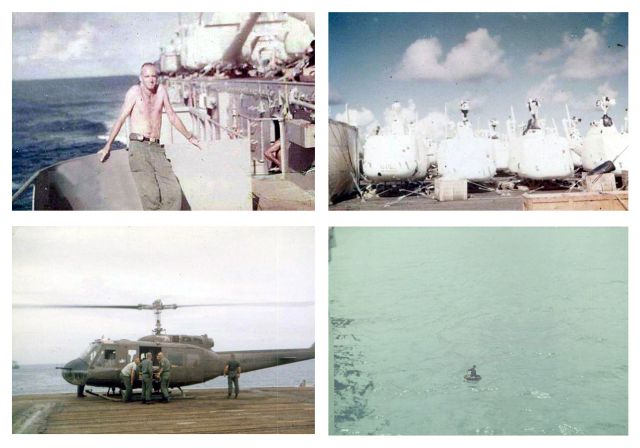
We stripped the "cocoon wrapping" off the aircraft and reassembled them. Every
part was marked when they were disassembled, so it was just a matter of putting everything back
and tracking the blades. It all went smooth. Pilots and crews were flown out, and they flew off with
the wooden blade boxes, and anything else that wasnít nailed down, sticking out the doors. They
flew to the beach and unloaded before leaving for An Khe.
Col. J.B. Stockton, Co 1st
Squadron 9th Cav, had a UH-1D C&C bird. He had an armament system complete with guns and
rockets on it. General Westmoreland flew out to the Kula Gulf and it just so happened Col. Stockton
was preparing to take off fully loaded. Gen Westmoreland made him shut it down and asked what
he was doing with the armament system on a C&C bird. We had to take it off on the spot. Col
Stockton was a hard taskmaster and unconventional, but his people loved him. His crew chief
told me the Col was going to get him killed, but he would go anywhere with him. The "Higher-ups"
were a little leery of him, because he really "got into" the Air Cav. It wasnít long before his armament
system was back on his aircraft.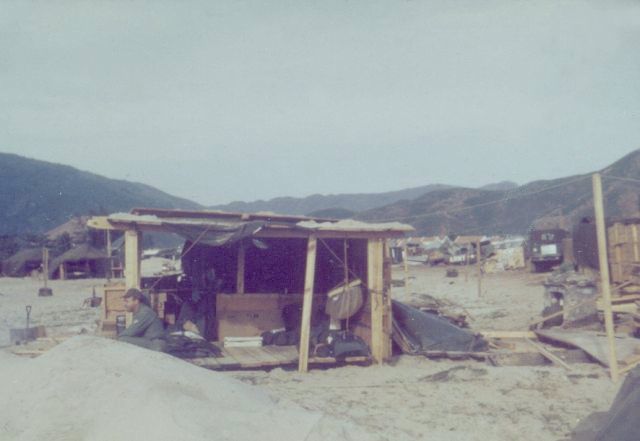
After we unloaded all the birds, we stole everything
that wasnít nailed down, and went ashore to a "graveyard" (the photo to the right). I think we were forgotten for a while,
and we ended up spending the night with people that sure couldnít hurt us. The next morning
some of us flew out and some went by truck. I was in charge of the convoy and had no idea
where were going or how to get there. Of course we were all scared and killed many bushes
going through the An Khe pass. We survived without anyone shooting at us. No telling how many
M-60, M-16 and M-79 rounds we expended at funny looking bushes. We drove through An Khe
village and the fixed wing airstrip. It looked pretty civilized, and I thought this wonít be too bad
after all (photo below).
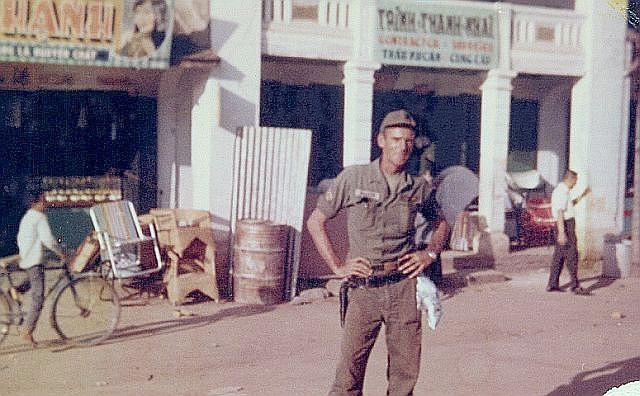
But we kept going. Then in a fairly flat brush covered area, I saw pup tents and helicopters
scattered anywhere there was clear ground. The dust, the trucks and helicopters taking off was
choking. There were people everywhere swinging entrenching tools at trees. What the hell were
these nuts doing? Axes and saws were made to cut trees. Where are the bulldozers and chain
saws? 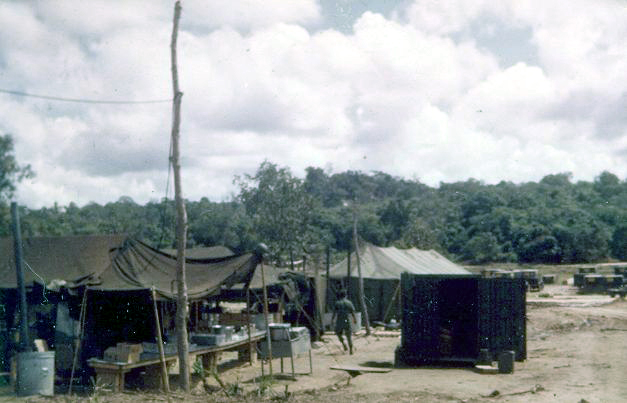
We reported to the company orderly room (a small GP tent), and we were paired
up, and were told to erect our Ďmansionsí. Pup Tents are not made for comforts. After pitching out
tents and trenching them, we reported back to the orderly room with our entrenching tolls as we
had been instructed to do. Not even a chance to wash the trail dust out of our eyes. The 1SG
pointed out an area that was brush covered, with bush branches anywhere from 1 to 6 inches
thick and told us to cut them to ground level. I was told Ďno axesí! I looked around to see Officers
and EM, side by side, swinging entrenching tools at trees. Oh well this is the Army. Several days
later we were starting to gain a little, but everyone from the CO down had severely blistered hands,
and war stories about the snakes they killed. The reasoning behind the lack of serious land
clearing equipment was to keep it from tearing the ground up We were still living in pup tents.
No showers. You took "spit" baths out of steel pots or a splash from the water buffaloes (water trailers).
Our mess hall was a cook tent with garbage cans with immersion heaters in them. The cooks
dumped cans of C Rations in the boiling water, and when you went through the chow line, they
would dip out a can and put it on your mess kit. It was pot luck. The same with the condiment
packets and the dessert. That would be our "Mess Hall" in the above photo to the right (smile)
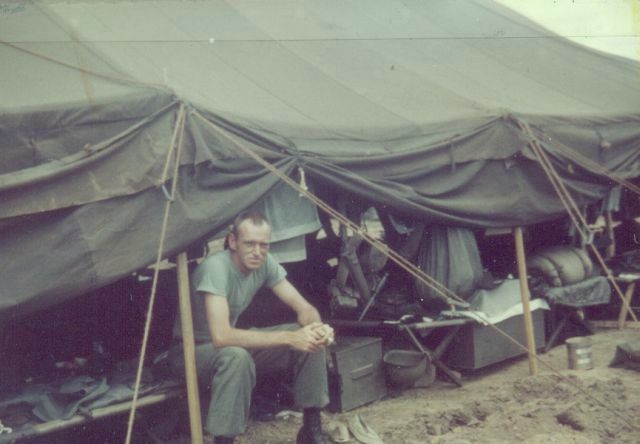
After a month or so, we finally got out of the
pup tents and into GP mediums (Ex: Left photo is me at our tent An Khe). It was a relief to
have a little room and cots By then our clothes were pretty well mildewed from the dampness.
When it rained, it was a lot better than when we were in pup tents. At least we could put our
belongings on top of the cots. Even though we trenched around the tents, the water still turned
the floors into mud. All the wood and equipment, we had appropriated from the ship, went into
maintenance areas rather than living areas. One blessing with the rain was the chance to take a
shower. Up to this time, my Army latrine experience was with slit trenches. Then, we were
introduced to barrels cut in half, with out house seats, instead of squatting over the trench. We
learned to live with the smell of the contents of the barrels burning. In those days, the odious job
of "burning sh..t" was done by a "detail" from the company, usually made up of people that had run
afoul of the 1Sgt.
While we were getting acclimated to the "Spartan" life style, we still had to
perform missions, and I was still trying to get out of maintenance. We had a sector of the perimeter
that we were responsible for among other things. Every evening, at a certain time, the entire division
had what was called a "mad minute". Every weapon on the perimeter "opened up" for one minute.
It was supposed to deter any attempts to penetrate the wire. It worked, because I don't recall
anything other than periodic enemy probes or occasional mortar rounds (that were just a nuisance).
We had a little time for the missions of the units to get "worked out". In field Maintenance, we were
kept busy doing routine maint. and repairing battle damage. At this time, I was in charge of the
recovery team. That kept us busy. If a helicopter went down, the "Blues" of the Cav would be inserted
to secure the site, Then we would be put in to rig it for sling loading.
One time, we got an
aircraft rigged, and a CH 54 came in to sling it. I was on top the helicopter to hook it up, when bullets
started hitting around me. I got the donut hooked up and the 54 went straight up, knocking me off
the top. I really thought I was "hit" at first, and just lay on the ground trying to get my breath (until
the grunts started yelling at me). The recovery ships came in, and it was a mad scramble to get
out of there. I think the bad guys let us rig it, so they could get a shot at the recovery bird. Another
time, was one of the 2/20 ARA birds with 48 rockets was flying mortar patrol around the base one
night, when radio contact was lost. We searched for it for two or three days. We couldn't find a
sign of it. One of the montagnards reported about where it had gone down. We started searching
and flew over the ridge where he said it was. The first thing we saw was a red seat cushion, on
a big flat rock, by a stream and then saw someone laying by the edge of the water moving and
trying to wave at us. There was no way to get to him, so we found a small clearing a couple
hundreds meters away. Another soldier and I got out and went back up the ridge. It was a long
fight getting through the brush, until we found the creek, and we waded upstream to where he
was. It was the Crewchief and he had a broken leg. He had stayed by the wreck, until he heard
us, then he crawled to the open area with the cushion. Some grunts came to assist us back up
the ridge, and we got back on our bird. We began searching for the aircraft and the rest of the
crew. We spotted a tree that had the top knocked out of it. There was a big wad of brush and
vines, that was completely out of place, with little glints of metal and glass showing. No telling
how many times it had been flown over the past few days and no one had spotted it. If we hadn't
pin pointed it, it would still be there. We had to go to it by foot climbing the ridge. The dead Pilot
was still in his seat strapped in. The dead AC (Aircraft Commander) was in his seat pinned
between the wreckage and a tree. The Gunner (also killed) was apparently thrown out, and a
skid was on top of him. We managed to get the Gunner out from under the skid, but couldn't
get the Pilots out because they were pinned in the wreckage. We "rigged" it and a CH 54 came
in to ďsling load" it. When the 54 picked it up, I managed to undo the Pilot's harness, and he fell
right in my face. I wasn't worth a damn after that. There was no way to get the AC out, so they
Ďslungí him out with the aircraft. That was the worst recovery I had anything to do with.
Between the recoveries and maintenance, we were working seven days per week. There were
four companies in the 15th TC Bn., with each one supporting different aviation units. C company
mainly supported the 227th AHB and some of the smaller units. CW3 Pete Foster (mentioned
earlier in Germany) and I ended up in the same unit again! He and I made a test flight one day
(we could do that). We took a few people with us just so they could cool off. We were a mile
outside the perimeter and trying to get some altitude, when we had a series of compressor
stalls and started losing power. Pete landed in a field along a ridge. We had no weapons and
the radios were gone. We pulled the particle separator, and couldn't see any problems with
the compressor or anything else, so we cranked back up. We couldn't get enough power to
get off the ground. Pete made everybody get out and said he was going to make "running" try
to get up. If he could, he would come back and get us?! He lifted off. It seemed like hours, but it
was just minutes when we saw an aircraft coming at us at grass top level. Pete had jumped in
another aircraft and cranked it. We found out later the bleed band caused the problem.
Another time, I was "running up" a Huey, when I heard a crash. My crew started yelling at me to
shut it down. I looked where the Crew was pointing. A couple hundred yards away, there was a
Huey lying on its side with the cockpit demolished. One blade looked like a pretzel and one was
gone. About a hundred yards away from the Huey, a Chinook had a gash in the side, with a rotor
blade sticking out of it. Maintenance had changed the blades, but it seems one came off at full
power, and killed the Huey Pilot.
At every opportunity, I was flying with one of the other
companies (mostly with the Gunship companies. They were always glad to get some relief). Most
of the AHBs (Assault Helicopter Battalion) consisted of three Lift companies (Slicks) and one Gun
Company (Gunships). The Guns mostly flew escort for the Slicks. They were UH-1B models with
flex guns and rockets. The "heavy hitters" were the 2/20 Aerial Rocket Artillery. They did most of
the LZ "preps". They flew UH-1Bs with 48 rockets. Later the "B" models were mixed with "C"
models. The first "C" model was "way over glorified".
During the Ia Drang campaign, I was
with a Maintenance Detachment sent to Pleiku to support the aviation units involved. We only repaired minor
damage. Most the major repairs were sent back to An Khe. There were a lot of recoveries however.
I was "racking" up on the flight hours.
This story has been told in thorough, factual
and historical context, but again, this was the first major battle involving the Army Air Mobility and
1st Cavalry. There were all the "targets" that any Helicopter Pilot could ask for! "Charlie" hadn't perfected
his anti aircraft gunnery. The eyes of the Division was the 1st Squadron 9th Cav. There were four
Troops; A, B, C and D. A, B and C that were Air Cav; and D Troop were "Ground."
The valorous Scout platoon flew OH-13s. They were manned with a pilot, and observer, and armed
with skid mounted M-60s and rockets and usually flew in pairs, followed by UH-1B Gunships.
I Ďbummedí rides on the OH-13s as the observer. We carried the M-60 and a case of mixed
grenades .We did grid searches looking for something that looked out of place. When we
spotted something, we would engage, intentionally draw fire, mark it with smoke, and let the
Guns have it. A couple days flying this way was nerve racking. When I flew with them, we never
took any fire. Some of them weren't so lucky. They took a lot of battle damage. One came home
with over 100 bullet holes in it and made it home. The 1st of the 9th Cavalry took a lot of casualties
at this time and lost a lot of aircraft, but they did what they were supposed to do. I guess some would
say maybe I had a death wish, but that was where I wanted to be.
After Ia Drang, we went back to An Khe.
It was about this time, I made Staff Sgt. Everything at An Khe was off limits, but if we had business,
we could go into town to take care of it. Of course, we always had time for a drink. I just happened
to have some business (buying some hot peppers for the mess hall), so I went to the "Ville". After
buying some peppers, I decided a few beers were in order, so I went to one of the local Bistros.
I was enjoying a beer when all the Vietnamese got quiet. I looked up, and saw a rather large
oriental in a Korean uniform come through the door. There was something about him that just
looked mean. He said something in Korean, and a beer suddenly appeared in front of him. The
bartender asked him something, and he put a grenade on the bar and waved his hand towards
the rest of us. I never have gotten a drink that fast. No one asked for any money or said anything.
For the rest of the time we were there, the beer was "on the house," and the service was exceptional.
When I finally left, the Korean was still there, and the grenade was on the bar. This was my first
experience with the Koreans!
By now, our tents had floors in them, made from ammo
boxes. Early one morning, I was sent to Qui Nhon, with a deuce and a half and four people, with
the instructions to pick up anything I thought the company could use. We had some AK-47s and
other assorted items to trade with. We also had a PX shopping list. The first stop was the supply
point. We drove right through the gate and no one stopped us. We were all carrying weapons. No
one we had passed in town was armed except the MPs. Once we got through the gate, we
wandered around looking for something to pick up. The first thing that caught our eye was a big
crate with "Electric Toasters" written on it. We picked it up and put it in the truck, but we needed
electricity (which we didn't have). Then we saw a 10 KW generator. A fork lift driver loaded it (for
a small token of our appreciation). We loaded the truck with lots of wood and other goodies. When
we went back through the gate, we were stopped by a Sgt. An AK-47 and a couple other items
bought our way out. We went to the PX, and while some of the others went inside, the rest of us
stayed with the truck. A bunch of kids gathered around us. Suddenly one started running away.
He had snatched a camera from one of our people. We started after him, but the MPs had
surrounded us. They saw that we were armed and went "nuts". A 2LT showed up, took our
weapons and ordered us to follow them to the MP Headquarters. We were escorted inside
and a Major started yelling at us for having weapons in town. We explained to him that we
had just come down Hwy 19 from An Khe, and that we were ready to go back. We were detained
for several hours and I was not allowed to contact my CO. Finally, the Major had us escorted out
of town, gave us our weapons back, and told us not to come back to town. When were escorted out,
it was just about dark, which put us going through the An Khe "pass" at night! Thankfully, the Koreans
had taken over security for the pass. When we got home,
the CO was waiting for us. I had to explain what had happened. He was mad as hell. He took me
straight to the Bn Commander, and I had to tell the story again. He asked the Majorís name and I
gladly told him. He assured me it would be taken care of. We never heard any more about it.
Apparently, a toaster appeared at Kinnardís quarters with no explanation.
After a while
at An Khe, it was off to Bong Son for a short stint. I was NCOIC of a FWD maint Det. Lots of free
time to fly and "play games." About this time, someone made the decision to lager a bunch of our aircraft
at a PZ to save a few minutes of flight time. Big mistake the enemy took advantage of it and mortared
the hell out of them.
One time at Bong Son, I was standing by the gate
to our compound one day, and a woman was approaching. An ARVN, standing beside me, started
yelling at her to stop. She looked at the ground and kept walking towards us. He yelled at her a
couple more times and raised his carbine. He shot her about 50 yards from us. She exploded
from attached ordinance. The ARVN apparently knew something. One night shortly after that, we
woke up with rounds tearing through our tent. There was a low sandbag berm around the tent,
and we hit the dirt behind it. The Koreans (on the perimeter) had actually let some "sappers" get
inside the wire and then opened up. The only damage done was "shot up" tents, and no sapper
survivors. They were trying to get to the flight line and our tents.
From Bong Son, I
went back to An Khe. A lot of changes had been made there. Our tents were framed, and the
company had real showers. Many had left, and replacements were coming in. We even had a
new Mess SGT. He had spent a lot of his own money building a mess hall (a real structure). I
don't know who he knew in Qui Nhon, but he was going there with a truck a couple times a week
and coming back with fresh meat and potatoes with all the trimmings. We ate on paper plates
and even had cold milk. The Support Command Commander was a guest at one of out meals
and the "secret was out." The Mess SGT was transferred to Support Command Headquarters
Company. About this time (July 1966), I was seriously considered extending, but I was told I would have to stay
in the same Unit. I flew out of Pleiku on a C-141 heading back to the "land of the big PX." I had hoped
to go to Ft. Bragg but ended up at Ft Eustis, Va as an Instructor.
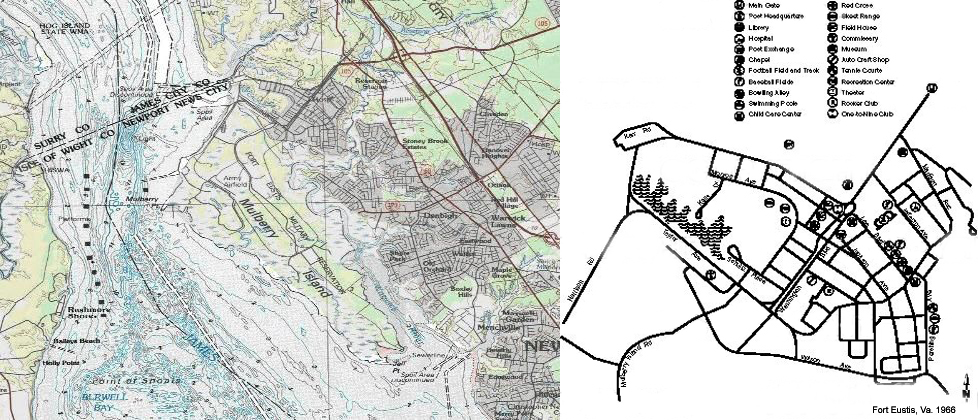
From the time I got to Ft. "'Useless", I knew I
wasnít going to like it. I was assigned to the engine "troubleshooting" branch. I had
to go to Instructor School to learn how to be a classroom instructor on the engines. I had already
taken instructorís courses in the NCO Academy in Germany, so it was no problem. The area around
Eustis (Va.) was nice with a lot to do, but the Fort itself was just a training area for people going to
Vietnam (they really had no interest in the courses). At least my branch was away from the main
part of the post.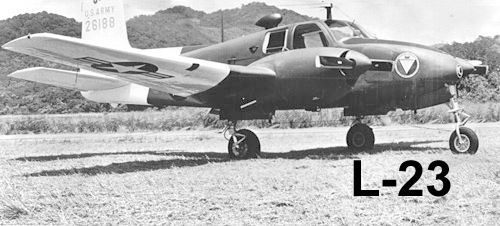
In 1966, we were teaching troubleshooting reciprocating engines
(that were on their way out). Maybe I would have felt better if we were teaching Turbine engines.
One of the highlights of my 18 months at Eustis, was when a Major in the branch managed to
get a L-23 (small twin engine airplane) for a day. This was quite a feat in itself, because aircraft
use was next to impossible. Anytime one of the Aircraft flew, they crammed as many pilots as
they could on board, just to get their minimums. Although it was an aircraft maint. School, there
was few available aircraft. The Major (Bates) asked if I wanted to fly with him, and I jumped at the
chance. When I got to the airfield, I was shocked to find out that the only ones going were him
and me. This was my first (and only) time I actually got "stick time" in a multi engine fixed wing
aircraft. We spent almost eight hours just flying around and landing at small air fields in Virginia,
Pennsylvania, and West Virginia. It was a beautiful day for flying. MAJ Bates was getting out of
the Army, and was looking for contacts for an aviation business. He was taking advantage of the
aircraft to further his business. It felt good to be flying just for pleasure.
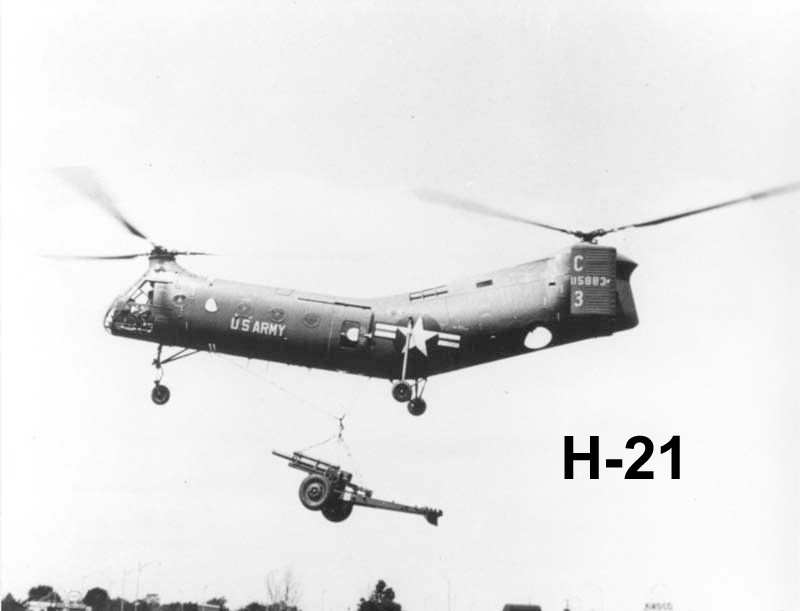
At the beginning
of 1967, I was chosen to go to school in Utica, NY to for the ignition analyzer. We were going to add
it to our Ft Eustis classes. I was willing to go anywhere to get away from teaching. After I got out of
school, I was back to teaching (mainly) this analyzer. A group of NCOS and two Officers came from
Ft. Belvoir for a special class. They were flying H-21s (right) for evacuation
of the Capitol in event of National emergency. A requirement was, anytime they flew over water, an
ignition analyzer check had to be performed. They had no one qualified to operate it. After I taught
the class, they went back to their unit and they started having problems. I went TDY to try to figure out what was going wrong. Before we were through with our investigation, every
one of the H-21s in the unit was grounded for magneto problems. If they werenít evacuation
aircraft for government figures, no one would have ever known there was anything wrong.
The H-21s were soon gone.
Finally I got enough of Ft. Eustis (and the "Stateside BS"),
and requested to be sent back to Vietnam. I loved the adrenaline rush and Eustis didnít have it. In
January 68 I was on my way back, assigned to 1st Cav. Div. again.
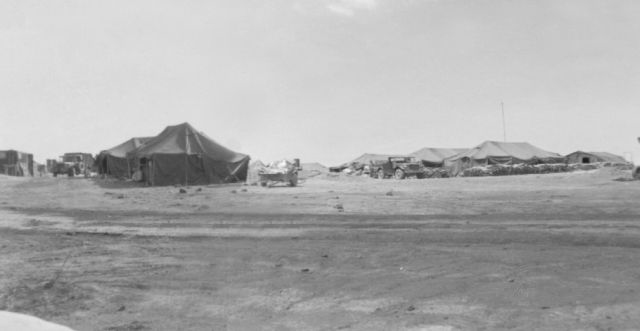
When I got to An Khe (photo above), I was surprised at how much it had been built up, but it looked almost
deserted. The "Golf Course" had a runway and the framed tents had been replaced with wooden
hootches. Except for "admin. types," the Cavalry was gone. The 173rd ABN had taken over. A
Brigade housed in a Division sized Base camp. When I got there, I begged, pleaded, and cussed,
to get to a flight Unit. I was ordered back to C Co 15th TC Bn, which was at Chu Lai.
We
were located close to the beach, in an old Marine area. The NCO hootch had the only hot shower
in the company, and was divided into cubicles. There were two USO shows that took advantage
of our showers to clean up. The officers were very jealous. And there was a strip of brush between
our perimeter and the Marines perimeter. The VC used to probe the wire and one or two used to
get in between us. There seemed to be a gunfight between us and the Marines, so the enemy
would leave. We had two forward detachments "out," and we really didnít have much to do, except
procure vehicles and other items, from anyone who left anything lying around, (especially the
Marines). I procured an M-60 and a shotgun for my personal use (when I could fly on missions
again). I had no intention of spending my tour on the ground bending wrenches. I was only at
Chu Lai for about a month when Tet (Jan 1968) broke out.
It seemed like overnight that we
were on our way to Phu Bai. Some of the company flew out, and I was elected to take part of the
Company on an LST (with most of the vehicles and heavy equipment). When we were boarding
the LST (troop landing ship), someone figured out that we had a lot more vehicles than we were
authorized, and we had to make some of them "disappear." We left with abandoned vehicles parked
everywhere. We went from Chu Lai to Danang where we off loaded. I was instructed to take several
vehicles, and was given a map to go to a Marine engineer compound in the hills overlooking the
Danang airstrip. I had about thirty men with me. As we got to the compound, we were informed
they were on 100% alert. We were given a sector of their perimeter to man, and the Marines
consolidated their people. I went to the TOC, and the Operations Officer asked where my OIC
was. I told him I didnít have one, so he gave me a briefing. During the day, we were given the
Ďruní of the area (as long as we manned the bunkers), but at night, we had to all be on the
Perimeter. The Operations Officer, a Major, suggested we use their range on the perimeter
to test fire our weapons and throw a few grenades. They had barrels and targets set up, with
plenty of grenades and ammo. We had a blast. I made sure my M60 worked. For some of my
people, it was the first time they had thrown a grenade since basic training. It was scary for
me because I was responsible.
We ate in the Marine mess hall, and it made us
appreciate the Army food. There was a K9 unit there, and we made friends with the handlers.
They had one German Shepherd that was "shell shocked." He was like a big puppy running
loose in the compound. He made friends with me, and everywhere I went, he was with me.
One of the first nights, we were all on the perimeter. I was in the center of our sector, and we
were on 50% alert. The moon was so bright you could almost read a newspaper. About midnight,
I saw an individual sneaking down the wire towards my position. When he got in front of me, he
started crawling through the wire. He was carrying something that looked like a weapon and had
a pack. Our Cav policy was; if he is in the wire- heís enemy, so I fired a short burst with my M-60
and he disappeared. It was just seconds, when a Marine 2nd Lt came up to me yelling, "Who fired
that weapon!?!" I told him I did. He let me explain what had happened. Then he looked at my
gun, and asked what the hell I was doing with a M-60 on perimeter (as opposed to the bunker).
I explained it was my personal weapon. Then he asked why I didnít ask for illumination. At this
point, I politely suggested he get out of my face and he obliged. At daylight, a couple of us
retrieved the individual, his AK-47 and his pack, which turned out to be a satchel charge. Later,
I was called to the TOC and was allowed to explain what had happened. The Operationís Officer
and CO listened to me. They informed me, that in the future, I had to call to the TOC before firing
my weapon, unless it was a major attack. I could not argue. They also asked me not to be "so
hard" on their 2Lt, for he was new in country. They both shook my hand and told me I did a
good job, but to consider my ass "chewed."
The next night, the outer perimeter of
the airfield came under attack. The following day, I was instructed to report to the 1SGT of one
of the compounds. When I got in my jeep, the German Shepherd jumped in the back seat. I tried
to get him out but he just looked at me. I drove to the dog handlers hootch, went inside and the
dog followed. I rushed outside and shut the screen door. He ran right through the screen and
beat me to the jeep. The K9 NCOIC told me to let the dog ride. Going out the gate, the guards
started to stop me, but the dog let them know it was his jeep and we were just using it. When
I got to the Company, the 1SGT approached the jeep. We heard the growl and I suggested he
not do that and he agreed. I was told to have my people, and vehicles, at an assembly point the
next morning. We were going to convoy to Phu Bai up Hwy 1. Not good. I went back to our
compound, and we started packing up. I told the Operations Officer what was happening
and he thanked us for our assistance. Then I tried to talk them out of the dog, but they
wouldnít give him up.
We drove through the "pass" with gun cover all the way, and had
no problems. When we got to Phu Bai we moved into another old Marine compound.
The Company was assigned a sector of the perimeter, and we were put on 100% alert
after dark. I was assigned the duty of setting up the perimeter. The Company just didnít have
a real job for me, so I started "bumming" rides. Soon, I was flying two or three times a week
with different Cavalry Units. The Battle for Hue was going strong, and the Marines were fighting
Ďhouse to houseí. The Cav was tasked to set up blocking forces around the city. We found
ourselves flying into Hue, and doing screening missions on the outskirts. A lot of shooting.
One of the missions I was on, resulted is us destroying a Catholic church at the road intersection
coming into Hue. The Marines were in charge of the battle, and were trying to avoid collateral
damage. When flying in support of them, we werenít supposed to fire rockets without special
clearance. As we approached town, we started taking fire from the church. When we took some
hits, we responded with rockets, miniguns, and anything else we could find to throw. When it
was over, there wasnít any stained glass left, and the building was completely "shot." We found
out later, that the Marine TOC was calling us to cease fire, but they were on the wrong frequency.
Hue was a beautiful place at one time, but when TET was over, there wasnít much left of it. Any
time we flew over the Citadel, "all hell broke loose." I felt sorry for the Marines. They didnít have
much air assets, and we did a lot of medevac missions. We were going in, where their helicopters
couldnít/wouldnít. They were still flying the H-34s at that time. The landscape around Hue was
littered with H-34s that had been shot down. The Cavalry was not as "restricted" as other Units.
The Division was being sent where the most problems were. So the 1st Cav moved from the
area around Hue, to Camp Evans. Camp Evans was a Marine Fire Base and the Cav inherited it.
It was about this time I got a real job. My Company stayed at Phu Bai, but they sent our
forward detachment to Camp Evans. The NCOIC had to go on emergency leave, and I was sent
to Evans to take his place. We were supporting the 227th Avn. Bn. & 15th Med, and anyone else
that needed help. We just did minor field maintenance and it still left a lot of time to fly. I flew mostly
with D Co 227th. They were flying UH-1Cs. The 1st of the 9th Cav was converting to
Cobras, and we knew it was just a matter of time before they would replace all the "C" models.
The 2/20 ARA was also getting some of them (that was a major upgrade from 48 rockets to 76).
I never liked to fly with 2/20. They seldom got below 500ft., so them getting Cobras was no effect
to me. The living conditions were back to the primitive (all GP mediums tents and one GP small).
Pilot CW2 Dennis Dunn and I lived in the GP small. We even had a refrigerator to keep our beer
(when we could get it). I had about 20 men under me, and we were supposed to be relieved in
three months. However, I was in a forward detachment for the rest of my tour. One of the first
missions was to relieve Khe Sanh. We worked with the ARVN 1st Infantry Div. They were a well
led aggressive Division at this time. We had to clear the Highway from Dong Ha to Khe Sanh.
One of the missions I really liked was at Khe Sanh, waiting for the call to go "low level" into Laos,
and blow up targets on the Ho Chi Minh trail. SOG teams would fix the targets. It was in and out.
We lost one aircraft from hostile fire.
fter securing Khe Sanh, it was decided to
abandon it. We were on to the A Shau Valley "hornets nest." That was a mess. The first day of
the assaults kept us busy changing rotor blades. None of the LZs on the ridges were "clear."
The slicks were using their rotor blades to cut the brush. We could hear them coming in before
we could see them. The rotor blade is the toughest part of a UH-1H. As long as the spar was
intact, it could take a lot of damage (but would vibrate like hell). Changing rotor blades was
a "science." We put a man on a wrecker boom and he steadied the blade while balanced on the
end of the boom. Knock the pins out, turn the boom, and flip the old blade off. Put a sandbag
on the end of the boom, the new blade on top of the sandbag, and reverse the process. Torque
the pins, track it, fly it around a pattern, and go. You never changed a "C" model that way. They
took some bullet holes, and we patched them.
The weather over the A Shau Valley
went to hell, and the Grunts were in trouble. We would take off from Camp Evans, climb out to
get on top, fly to the valley and find a "sucker hole" to go down in. After unloading, it was back
up through the "soup," and vector back to Evans.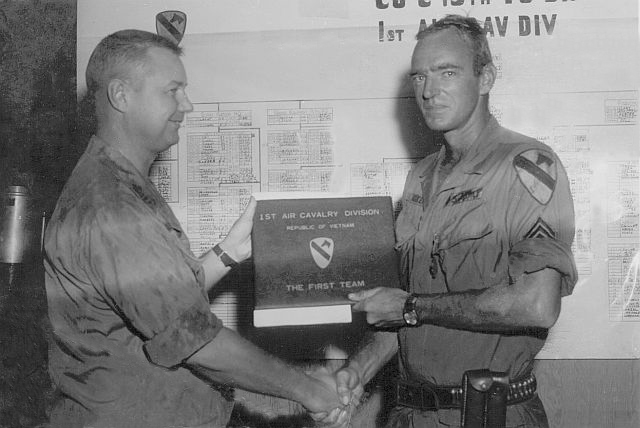
The above photo was taken in 1968 at Phu Bai. They had to chase me down to award me the DFC for being stupid. On 19 May 1968, I left the perfect safety of a bunker during a mortar and rocket attack on Camp Evans, with CW2 Dennis Dunn to try to evacuate aircraft. After a couple of the helicopters were hit, we managed to get into an "H" Model that was parked right next to the fuel storage point. We got it in the air and out, and then we "got stupid." We decided to try to get another one out. We were going to land (the one we were in) at a ravine on the other side of the base and try for another. We were eastbound at approximately 500 ft, overflying the enemy positions, when what appeared to be an "A Bomb" (See a Personal Account of another Soldier and Aircraft that made it out at: "The Ammo Dump Big Blow") go off where we had taken off from. Dennis yelled he couldn't see. All the dirt and debris in the aircraft was swirling around. I saw "ground" rising up to meet us. Dennis had so much crap in his eyes that he was temporarily blind. I grabbed the controls and I managed to get in a level attitude, but the skids hit. I pulled on the collective, but we hit the ground hard (but level) and we bounced airborne again, but we flipped. The second impact was inverted. Apparently, the mast had sheared on initial impact. When the dust settled, I released my seat belt and fell on my head. The greenhouse was gone. I took off running, but I heard Dennis yelling. He was still strapped in, with the roof on his side crushed almost to the top of his seat. He hadn't fastened his shoulder harness and was thrown forward. We pulled him out and Dennisís first words were, "Letís get the hell out of here!" We were real close to where the mortars were firing from. The base was on 100% alert and we had to get back in. Somehow we made it. I was a little "cut up" and Dennis had a dislocated shoulder. The next day, we went back out to the wreck with the flight surgeon and some investigators. The main rotor system was laying about 75 yards away. The skids were at the initial point of impact. It was determined that the engine was not running on contact. The theory was; we were caught in the shock wave of the fuel dump explosion. The main rotor mast sheared. Dennis and I should not have survived.
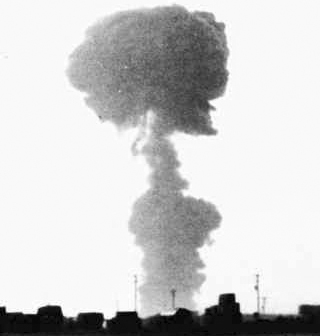 During this disaster, a fuel tanker parked next to a bunker, took a falling
round that knocked a hole in it, and was leaking fuel into the bunker full of men. A 19 year old PFC
Long (who was in my Det), jumped into the truck, and drove it to the perimeter streaming fuel. He
jumped out of it, while it was still rolling, and broke his arm. He was awarded a Silver Star and
Purple Heart. The next day, Camp Evans looked like a wasteland. There were rounds laying
everywhere. Everyone was wandering around "shell shocked." Our Company Commander flew
out to check on us. When he landed, he almost stepped on a 105 round. He immediately got back
in his aircraft, and left. We didnít have much left. We did have a UH-1B that we had in
maintenance from one of the other Cav troops. It was listed as a combat loss. A 105 round had
come through the roof and hit one of the beams. The "rebel" in me came out, and we opened it up,
and the damage to the beam wasnít as bad as we thought. It was still depot level maint., but I had
some outstanding sheet metal people. We fixed it and started flying it! I know we were not overly
smart, but in those days, we were ten feet tall and bullet proof. Dennis Dunn had left because of
his shoulder injury, and they temporarily sent me a WO (Warrant Officer) named Wayne Babcock.
We flew the "B" model for about a month before anyone realized we had it. We used it for parts runs
and beer runs to Danang. It was a good aircraft in spite of the damage. The 1st of the 9th had lost
a lot of aircraft, and someone found out we had one that we werenít supposed to have, so we lost
it. Nothing was ever said about our unauthorized repair.
During this disaster, a fuel tanker parked next to a bunker, took a falling
round that knocked a hole in it, and was leaking fuel into the bunker full of men. A 19 year old PFC
Long (who was in my Det), jumped into the truck, and drove it to the perimeter streaming fuel. He
jumped out of it, while it was still rolling, and broke his arm. He was awarded a Silver Star and
Purple Heart. The next day, Camp Evans looked like a wasteland. There were rounds laying
everywhere. Everyone was wandering around "shell shocked." Our Company Commander flew
out to check on us. When he landed, he almost stepped on a 105 round. He immediately got back
in his aircraft, and left. We didnít have much left. We did have a UH-1B that we had in
maintenance from one of the other Cav troops. It was listed as a combat loss. A 105 round had
come through the roof and hit one of the beams. The "rebel" in me came out, and we opened it up,
and the damage to the beam wasnít as bad as we thought. It was still depot level maint., but I had
some outstanding sheet metal people. We fixed it and started flying it! I know we were not overly
smart, but in those days, we were ten feet tall and bullet proof. Dennis Dunn had left because of
his shoulder injury, and they temporarily sent me a WO (Warrant Officer) named Wayne Babcock.
We flew the "B" model for about a month before anyone realized we had it. We used it for parts runs
and beer runs to Danang. It was a good aircraft in spite of the damage. The 1st of the 9th had lost
a lot of aircraft, and someone found out we had one that we werenít supposed to have, so we lost
it. Nothing was ever said about our unauthorized repair.
Shortly, I got another WO from
the Company, to fill in for a short time. He had never fired any rockets, and he wanted to bad. One
of the gun ships was coming in for some maint., and I talked the gun people into leaving it loaded.
The WO1 and I went up looking for something to shoot at along the beach. I saw a NVA run out
of a hedge row, and into a hootch carrying an AK47. There was our "target." I pushed in the breakers,
and told him to "have at it" (selecting a pair at a time). He fired about six rockets. He had put them
all around the hootch but hadnít hit it. I fired a pair and they went right through the door, and the
NVA flew out the roof! He wanted me to shoot again, but I wasnít about to show it was just luck.
He fired the rest, and we went home.
We had none of the comforts of the Company area.
Everything we had we scrounged or stole. Every time one of my people had to go to the Company
for anything, they caught hell for looking so raggedy. They actually looked like a bunch of Grunts.
The 1st Sgt kept sending messages for me to come to the Company area. I kept making up excuses,
but one day I had to go. As soon as we landed, someone told him I was there, and he came running.
As soon as he saw me, he took me to the supply room, and I got a new flight suit, some new
fatigues and from there to the barber shop. I was waiting for the "chewing out," but it never came.
He took me to the COís office, and there was a photographer. The CO gave me a DFC for my May
19th "Stupidity" (see above photo), and asked if I was ready to come back to the Unit. I told him
thanks, but no thanks. I had a pretty good life doing whatever I wanted to do. Also I had a great
bunch of men working with me. The company was having drug problems and my people were
pretty straight. We did drank a lot of booze.
I went back to the area of B Co 227th. They were
one of the slick Companies, that we ( C 15th TC Bn) were attached to, that provided our rations and living area, but they really had no
control over us. Shortly after that, I was promoted to SFC E-7. One day, the D Co Commander
asked me if I was happy depending on B Co. I told him that I had no problems. He then told me
that D Co was moving south, and he wanted me with him. I told him yes, but I
didnít think it was my decision. He said he would "take care of it." The final outcome was; My
Detachment went to "Bearcat," but I stayed forward with the Aviation Units.
We arrived at Phu Loi and life was good. We had very little to do (because most of the
Units we had supported were in Lai Khe), so there was a lot of "flight time." One of the Air Cav troops
was there, and they had OH-6s (Cayuse/ a small helicopter). WO1 Wayne Babcock was "checked
out" in the OH-6, but we had no one to work on them. So, it was a lot of following TMs (technical
manuals). They also had Cobras, and I had been "schooled" on them. No one else in my detachment
knew anything about them. Then D Co started getting more Cobras (a couple at a time) phasing
out the UH-1C Gunships. The Company got a new Commander who was strictly a "Cobra man."
The morale in the Company went down. The Crewmembers lost their flight status, and the
camaraderie between the pilots and the crews disappeared. This new Commander didnít like me,
because he thought his Unit and Aircraft should get priority. The only priority we had was to the Dustoff Units. I started complaining to some of the B
Co Officers, and CPT Redondo (a Platoon Leader of C 15th) came out to find out what the problem was. He and the D Co MAJ
had words, and we were told to "pack up."
We went back to my detachment C 15th TC Bn (at Bearcat) . Our old
Company CO said we had been "forward" too long, and we needed a rest. I was only back a couple
of weeks, when he called me in. He asked me to go out with another Detachment, just to help them
get started. I couldnít say no. I was told it was just temporary. I only had a couple months left. We
(this new Detachment) went to Lai Khe, where we lived pretty well. The village was surrounded by
the compound, and we could go to town. Lai Khe belonged to the 1st Infantry division. They didnít
care for us. We were wild, and didnít have to "play" by the same rules that they did. We had a new
Commander that really showed an interest in us. He made sure we had what we needed, so we
didnít have to depend on anyone else. The NCOIC was outstanding. He was dedicated to
maintenance, so I really didnít have a job. I was getting very "short." About a month later, CPT
Redondo came to Lai Khe, and told me to pack my gear. When I got back to Phu Bai, the Co. told
me I was going further south, on an advance party to a Navy base in the Delta (preparing for a
possible move). He gave me a jeep and trailer and one man. We loaded all in a Chinook and landed
at Bin Thuy Navy base.
There was a short runway and heliport with a couple UH-1C
gunships. The base was built up with wooden barracks, complete with air conditioners. I didnít
see any way that we could be sent there. The Navy knew what I was there for, and they felt the
same way I did (about the Army moving there). After a week, I was getting bored. We hadnít heard
anything from my Company, so we didnít know what to do. Finally I went to the Seawolves
(Navy helicopter Unit) and begged to fly with them. I was told no way. They explained to me that
their requirements were much more rigid than the Armyís. They also told me about the Navy
Combat Air Crewman school they had to attend (I remembered that from my Navy time). The
base was also a PBR (an armed river patrol boat) base, so I asked to work with them. Their
answer was "hell yes!" I rode the PBRs enough to really appreciate what they did. It was a lot
more exciting than flying. It was all up close and a lot of action. I would man one of the M60s
or a 50 cal. There was a lot of recon by fire along the canals and river banks, and occasional
SEAL insertions. Those guys were nuts. Being an E7, I was accorded all the privileges of a
Chief Petty Officer. Even in a combat zone they lived good. I was there for a month or so,
and I donít know how many times I had steak and lobster tail. Shrimp was a regular meal.
I asked them how they managed to eat so well, and the Mess Chief told me he ordered the
rations from the Army and they supplied them!
Soon it was time to return to Lai
Khe, just in time to DEROS back to the states. My orders were to return Ft. Eustis! It was
too late for me to extend, so I was "stuck."
When I signed in to Ft
Eustis (1 Feb 1969) again, I let everyone
(that I talked to) know that I had no intention of staying. The "stay" cost me money. Flight pay was
almost impossible, and I could not get "jump" pay. The fifty five dollars, that I was accustomed to
earning, was a lot of money then. At Eustis I lost that kind of income and was not ready to do that.
They didnít know what to do with me. One day at the PX, I heard a voice yell at me: "What the hell do
you think youíre doing!?" It was LTC Merle Bounds. He had been promoted to Chief of the Air
Transport Branch. I told him I had just arrived at Eustis, and was going to leave anyway I could. He
asked if I wanted a job, and I politely told him no. He told me where his office was and to come see
him ASAP. A couple of days later I did. I still had my records. He was out of the office and his Sgt
Major asked what I wanted and I told him. About that time Bounds walked in. The Sgt Major
immediately jumped up standing at attention. To me the visit was social, so I just leisurely stood
up (getting a nasty stare from the Sgt Major). Bounds was glad to see me and told me to come
into his office. He turned to the Sgt Major and told him to bring us a cup of coffee. In addition, he
told him that he didnít need to see my records. He told me he needed an NCOIC of one of his
sections. I again told him I needed to get out of Eustis because of my pay status and being an
Instructor would not change that. He informed me that I wouldnít be teaching classes and that I
would earn flight pay. I went to work for him.
The section mainly taught loading of Air
Force aircraft. We had two AF Loadmasters and two Army NCOs. The Section Chief was Major
Edwin Harris (and there were some other Officers and civilians). Major Harris was real easy to
work for. He was a dual rated pilot with a couple of tours behind him. His last tour was with the
Americal, I canít recall which unit. It was very difficult to get my four hours a month of flight time
for the flight pay. A couple of months later, the Sgt Major called to tell us that the Colonel (Bounds)
was coming to "visit" the Section. I told everyone there that he was on his way, and "suggested"
they go for lunch, and I would stay. They agreed and left. When Bounds arrived (I was the only
one there "snapped" at attention), he asked where everyone was. I told him I had heard he was
coming and sent everyone to lunch. Bounds broke out laughing (the Sgt Major was most unhappy).
Bounds asked how everything was going and asked if I needed some flight time.
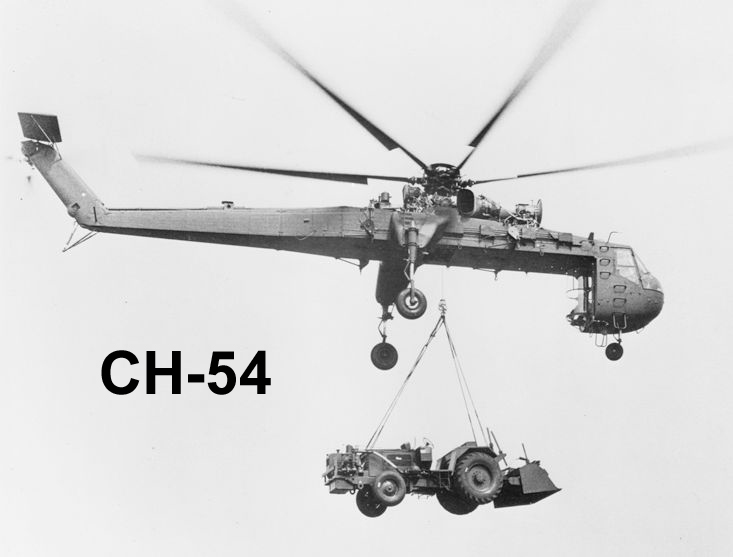
That
afternoon, he was flying the CH-54 (the one that Ft Eustis had), and asked me to go with him. I got
to ride in the Flt. Engineerís seat facing the back. It was different. Flight time is flight time though.
One day, he managed to crash it on the ramp. No one was hurt, but Ft Eustis lost their CH-54
(It turned out that he was not current in a CH-54).
About this time, a lot of Army draftees
were arriving to the Fort (part of "McNamaraís Hundred Thousand"). They were going through the
very basic Stevedore School, and then they were supposed to be able to load any cargo on
anything. This schooling was the least mentally challenging job that the Army had to offer. They
were very bored and unhappy. We had to laugh at them. A few of them took it in stride, but most
hated it.
Finally, Bounds decided to retire. I knew then, his Sgt Major would be after me.
I asked for transfer to anything I could get, which led me to volunteer to go back to Vietnam.
I went to the assignments branch and an NCO (which I had known some years back), arranged
(December 1969) my orders to the Americal. I knew nothing about the Division, so I asked Major
Harris, and he gave me a breakdown of the aviation assets. I asked what would be a good unit
and he told me that the 174th Assault Helicopter Company would be a great choice.
While I was home on leave, my brother was
in basic training at Ft. Polk. I went to see him, and basically told him not to go to Vietnam. If one
member of an immediate family was serving there, another family member did not have to. He was
smarter than I was, and spent his "time" in Maryland. I got to Chu Lai, RVN in late Feb. 1970.
Actually, when I got to the Americal, I was given the choice of going to the 176th AHC or
the 174th AHC. I remembered what Major Harris had told me, so I opted for the 174th. This was a
move I never regretted, but I was assigned as a Maint NCO. Damn. The first thing I saw was those
" Charlie" model Gunships (Sharks) sporting the ferocious teeth across the nose and the painted
rear access panels. I knew this was where I belonged. Now all I had to do was get assigned to the
Sharks. Rex Hurst was the Shark Platoon SGT and when he rotated, I wanted his job. There was
a Maintenance Platoon SGT and I was the Maintenance SGT. So, I worked in maintenance, getting
my feet on the ground, but I was still "conniving" to get into the Sharks. When Hurst rotated, I saw
my chance. I talked to CPT Riddle, (who was the Shark Platoon Leader at the time), and he told me
I had to get MAJ Blackburn to reassign me, but they gave it to a SSG that was in maintenance. He
was unhappy and didnít want it. I started flying with the Sharks every chance I got. It seems they
were always shorthanded. I even re-armed, pumped fuel or helped clean the aircraft. All the
Crewchiefs and Gunners were dependable (and they were all a little on the "wild side"Ösmile).
I was still in Maintenance when the Shark went down outside Quang Ngia losing the
entire crew (click here to see the story:
ĒCrew Losses
SectionĒ). The friction collect safety wire breaking had been a continuing problem with
the Aircraft. I was the last one to re-torque it and safety the wire, so I jumped on an
aircraft going to the site. As soon as we got to it, I climbed through the wreckage and saw
it was still intact. That was a big relief. There was a non-rated W4 with us and he started
taking pictures of the wreckage, and there was a boot that still had a foot in it. He started
taking close-ups of the boot, and I "lost it." He quit taking pictures. I picked up one of the
M 60s that was lying by the wreck, and brought it back with me.
Everything from the
crash had been "written off" as a "combat loss." I took the M-60 to the armament shop to the
NCO (I believe his name was Hawkins). We disassembled it and managed to salvage the receiver,
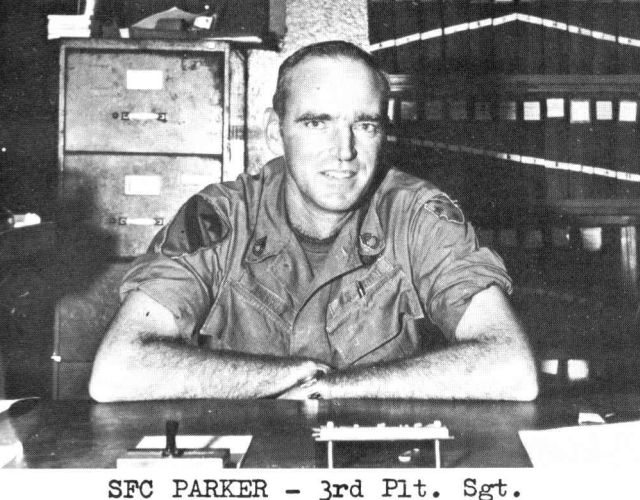 but had to junk everything else. I took it out and it would fire a few rounds and then jam.We
built it up with new parts, and it was my "personal" M-60.
but had to junk everything else. I took it out and it would fire a few rounds and then jam.We
built it up with new parts, and it was my "personal" M-60.
Major Blackburn finally got
tired of me asking for the Sharks. He told me he didnít want to hear anything more about it,
and I would never get in the Sharks as long as he was there. About this time that the above
mentioned Shark Gunship went down, a Dolphin slick
was shot down in an LZ. The Crew thought the CE was dead and he was left behind. Later, he was
found to be still alive (but later died). The Gunner was blamed for leaving him, and was
kicked out of his Dolphin platoon. The Gunner became a "basket case." So, I took him "under
my wing" and tried to help him. Later, he was to "save my ass."
I was at the PX one
day, and one of the companyís Ďproblem childrení (a "doper"), started screaming at me in the
line. I told him I would see him back in the company area, and I left. I was walking down the
company street, and he came out from behind the hootches pointing an M-16 at me, yelling he was
going to kill me. My ex-Gunner tackled him and took the M-16 away. We took him to the orderly
room and the MPs picked him up. He was banished from all of the fire bases (with orders), and
never to come back to the 174th AHC area. To this day, I canít remember the Gunnerís name. I
owe him my life. As to the "doper," I later saw him going into one of the headquarters platoon
hootches. I followed him in, and caught him with a large amount of "dope." I escorted him
(physically) to the Orderly Room, and that was the last we ever saw of him.
Finally,
the day before Major Blackburn left, he asked if I still wanted the Sharks. Of course I said
yes, and he gave me the position (Platoon SGT).
Just before I got the Sharks, CPT Ackerman had
taken over the Shark Platoon as Leader. Everyone had great respect for CPT Ackerman. He earned the
nickname of "Captain Strack". I would fly three or four times a week (usually as a Door
Gunner/sometimes as a Crewchief). At this time, we were very "shorthanded." We could man
"primary" and "secondary" teams and maybe have a couple people for maintenance.
One
day, while flying with CPT Ackerman (I canít recall the other pilot), we spotted a "dink"
running into a bunker. We landed the Gunship, and the Crewchief and I ran to the bunker to
try to snatch him. We couldnít get him to come out, and not being crazy enough to go in after
him, CPT Ackerman told us to throw a grenade in. For some reason, we didnít have any grenades,
so he told us to throw "smoke" in. We threw three or four purple smoke canisters in the bunker.
Later, some Grunts got him out, but the smoke had killed him. Around this same time period, CPT
Ackerman, WO1 Bruce Marshall and SP4 Bob Jansen were flying lead Gunship (I don't know who
the other Crewmember was). I was in the trail bird (canít remember my other Crewmembers either).
This Shark Team was going from point A to point B, doing our usual thing (playing like Loaches),
when CPT Ackerman spotted a large poncho. It was definitely out of place. He did a 180 degree
turn-about and spotted five enemy soldiers run out from under it. He punched off some rockets
and Marshal shot one with miniguns and Jansen shot one with his door gun. I took the pictures
below. Ackerman was like that. He could spot the enemy faster than anyone else. I thought I was
pretty good at that, but he was far better than everybody.
*Webmaster note: Bruce Marshall recently added: ďDale Parker nailed the story as
far as I can recall. Any memories I could add would quite possibly have some others avoiding
gunship pilots.Ē- Bruce
 top left photo, you can see (possibly) the five enemy suspects under a poncho. The right photo shows
the "aftermath" (enlargement centered at bottom). You can see a trail and a brown spot in about
the center of the picture. It is just a small burned out spot. On the top edge of the brown spot
there is a light colored small object. That is a poncho. Just above that there is a small pool of
water then the river. There are five dead mostly around the small pool of water.
top left photo, you can see (possibly) the five enemy suspects under a poncho. The right photo shows
the "aftermath" (enlargement centered at bottom). You can see a trail and a brown spot in about
the center of the picture. It is just a small burned out spot. On the top edge of the brown spot
there is a light colored small object. That is a poncho. Just above that there is a small pool of
water then the river. There are five dead mostly around the small pool of water.
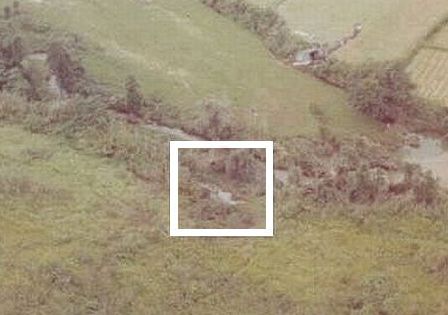
And another time, the
Company had inserted some ARVNs by one of the hamlets along the coast. The Shark Guns were
snooping around the area, when I spotted a young female running away from the ARVNs (down a
rice paddy dike carrying a pack). CPT Ackerman had the idea of trying to snatch her. He
hovered over the dike in front of her, and I jumped out missed the dike and fell flat on
In the
my face. Then when I tried to get on the dike, I fell off the other side. I finally grabbed
her, and I donít know if she was laughing too hard or was too scared to put up a fight, but
I threw her and her pack into the gunship. They circled around to pick me up and then I saw
her flying out the door! The CE had thrown her out into the rice paddy. It turned out that
the pack she was carrying just had a little rice in it. I took two showers that night.
I
was in the Shark "line shack" one morning when one of the Dolphin Platoon Sgts came in and
asked me to go with him. He was acting nervous, and I went with him to the Dolphin Platoon
"line shack." He pointed out a grenade hanging from one of the lockers by a piece of safety
wire attached to the pin. Apparently, someone had attempted to booby trap the door so that when
the door was opened, the grenade would fall and they the weight would pull the pin. Whoever
did it had straightened the pin, but the pins donít "pull" easily. I took it down and we
reported it, but never heard any thing more about it.
Our "flareship" went down one
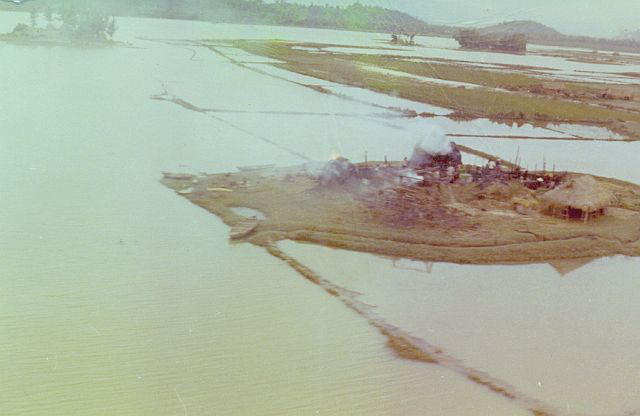 night (I was flying on the same mission), and the next morning, I went out on one of the Dolphin slicks
looking for it. We picked up a trail of flare chutes and we figured out which direction he
was heading. We flew across a ridge with an Grunt NDP (night defensive perimeter) on top.
We made contact with the unit and we were advised a helicopter had flown over their heads,
just missing the ridge in the night fog and threw out a flare. We figured out the elevation
and direction and pinpointed where the flareship would have hit the side of another ridge.
The weather was so poor that we had to go back.. A Loach found the wreckage where we thought
it would be.
night (I was flying on the same mission), and the next morning, I went out on one of the Dolphin slicks
looking for it. We picked up a trail of flare chutes and we figured out which direction he
was heading. We flew across a ridge with an Grunt NDP (night defensive perimeter) on top.
We made contact with the unit and we were advised a helicopter had flown over their heads,
just missing the ridge in the night fog and threw out a flare. We figured out the elevation
and direction and pinpointed where the flareship would have hit the side of another ridge.
The weather was so poor that we had to go back.. A Loach found the wreckage where we thought
it would be.
We were flying a "snatch"
mission on the lake south of Duc Pho one day. We flew Gun cover for a slick that was low-level
looking for military age males. When they spotted one, the slick would hover over him and try to
"snatch" him. If the suspect was in a boat, the rotor wash would turn the boat over making the
snatch easy. One tried to get away and went into a small ville' on an island. We marked it with
yellow smoke grenades, but we caught the whole village on fire (see right photo). Small arms
ammo hidden in the hootches started going off. We started throwing yellow smoke on other
hootches and detonated more rounds. We were finally called off.
I was flying Shark Door
Gunner for Mr. Jim Kinne when he got hit in the leg.
*Assistant Webmaster note: Dale is speaking about the first leg wound Jim Kinne received in early
Nov 1970. Kinne returned to Shark flight status (two weeks later) only to be wounded again in the leg.
This time, very seriously. Dale Parker was flying at Door Gunner this time as well. See a detailed story
and photos at: "Fred Thompsonís Biography."
One of Fred's photos that day (22 Nov 1970) is below. That is SGT Parker pointing out just one of the
many rounds exit holes.

Scott Sparks was the CE. We were flying an "Eagle flight" around the "Horseshoe"
(a particular "nasty" area
west of Quang Ngai) and hadnít seen
anything, so we started along the river to Quang Ngai. We were over an ARVN AO (area of operation),
when I spotted a
male carrying a weapon running towards a bunker. I "opened up" on him, and told Mr. Kinne what I
had seen. We came back around, and I spotted several people carrying weapons and heading
towards the
river. Scott saw them too, and we both started firing. Mr. Kinne began yelling "cease fire," because
some of them were women. About that time, one "opened up" with an AK-47 and Mr. Kinne yelled
he was hit. The Co-Pilot landed on the edge of the area. "Sugar Bear" Gambrell was flying "wing"
and really "fired the area up," when we got clear. The Grunts were inserted, and we loaded Mr Kinne
on a slick. I had gotten some shrapnel in me, but that was nothing uncommon, so I thought nothing
about it (although I was mad as hell). Another Shark was scrambled to replace ours. SP4 Bob Jansen
jumped out of the replacement, wearing shower shoes, fatigues and tee-shirt. Some Captain started
"chewing his ass" (It wasnít one of our officers). I politely asked him not to talk to my people that way
under these circumstances. He didnít argue with me. I took Jansenís place and sent him back. Our
bird was "slung out." I finished out our missions, and when we landed, the Flight Surgeon met us.
He "started in" on me before I even got my helmet off. I had no idea what he was mad about. He told
me to follow him and I did. When we got to his office, he started pulling little pieces of metal out of
me! He was not gentle about it, and he continued to "chew me out" every time he pulled one. It
turned out that he was worried about infection. Pieces of aircraft, Plexiglas and rocket wires were
just a fact of life for me. I received a "Kerry Purple Heart" out of it.
At this time (at Duc Pho),
the other Platoons were getting upset because the Sharks rarely made Ďformationí or "police calls."
The 1SGT called me in and wanted to know why. I explained to him that we had a primary team just
getting off duty (which was four people), then a primary team going on duty and getting the
Gunships ready (which was four more people). Thatís a total of eight. Then the secondary team
would be getting ready (which would probably include me- the Platoon Sergeant). The most I
could have in formation in the morning? Maybe four. That pretty well ended the fuss over formations
and police call. The Sharks were always short of crews. At the risk of making some upset, I feel we
had the "pick of the litter." With people like Bud Vann, Tom Taggart, Bob Millius, Mark Hodgkins,
John Moore, Yogi Reeves, Bob Jansen, Scott Sparks, Jimmy Long and later Bill Wilder
(and others, but I can't recall them all), you canít go wrong. They were all a little on the "wild side" but
that is what it took. There
were other stories that have been documented that I wonít repeat. We also had some of the best
Pilots I have ever flown with. There is a certain "mental thing" that has to be there, that not everyone
has.
It is not that they were any smarter, but they just had that little "edge."
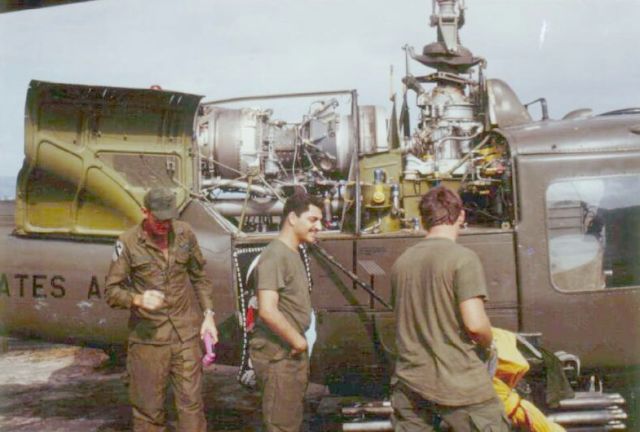
To the right: Fred Thompson Photo
1971. L-R: Dale Parker, SP4 Jimmy Long and SP4 Tom Taggart "maintaining" Shark #540 "Grim Reaper."
Wait a second. Is that SFC Parker on a "police call" with a pink toy plastic hammer?
Vietnam wasnít bad, but
things were about to get very bad. Around the first of the year 1971, I noticed the Vietnamese that
were working in the company area started acting a little strange and "stand-offish." One of the hootch
maids in the NCO hootch, told me one day that we were going to a bad place and many people would
get hurt. Then we began trading our aircraft for ones that had more time to go before maintenance
was due. We actually got some low hour aircraft in pretty good shape. I was given two 50 cal
machine guns! Finally, we were told to get ready to go, and that we were moving North, and to
expect serious losses. We were also ordered to leave everything behind that wasnít absolutely
necessary for us to have, as we were carrying it all with us on the aircraft. We had all the Sharks
Gunships ready to go, but not enough pilots or crew for all of them. Some of us (non-pilots) flew
Ďleft seatí when we left. I left the 50s behind, because they were so heavy, and they beat the hell
out of the airframes. We only had two or three aircraft that we could mount them on anyway. If I
had known then, what I was to find out, I would have had one for every Shark and the mounts for
them!
During Lam Son 719, the Sharks were initially used to support American troops
securing the highway to Khe Sanh. The orders to establish a FSB (fire support base) on the
"Razorback" (a large nasty ridge near the DMZ), was my first indication of what we were looking
at. We were a ďheavy Shark gun team" of four gunships and staged at Vandergrif. After air strikes,
and a lengthy artillery bombardment on the ridge, followed by ARA Cobras, we escorted the
slicks in. The slicks got the hell shot out of them, in spite of all the "prep" we put down. They
finally pulled off, and the "prep" started again. There was so much fire and cover, you couldnít
tell where it was coming from. Another CA was attempted with the same results. After another
lengthy artillery "prep," CPT Ackerman split the team into two teams. I was flying with CW2 Greg
Manuel, LT Bob Hackett and SP4 Mark Hodgeson. We came in from the other side of the ridge
with CPT Ackermanís crew in front (us in trail). We flew up a draw, and all hell broke loose, with
fire coming from everywhere. We were all shooting and "punching" rockets. All of a sudden, our
Shark (#170) lurched and CW2 Manuel yelled he was hit. Bob grabbed the controls, and we went
back down the same way we came up. I noticed I was the only one firing. As soon as I could, I
checked on Greg. He said he was OK, and I looked at Mark. His visor was down, and it looked like
blood was pouring out of his face. I thought he was hit bad, but he said he was OK. We made
back it to Vandy, and #170 was "hooked out." Greg was evacuated to the states. Mark was cut
up with shrapnel. Bob was OK and flew us back. I just had a couple of cuts, probably from
getting Greg and Mark out. Pictures of a damaged #170 are on this website in other places.
Two of mine are below.
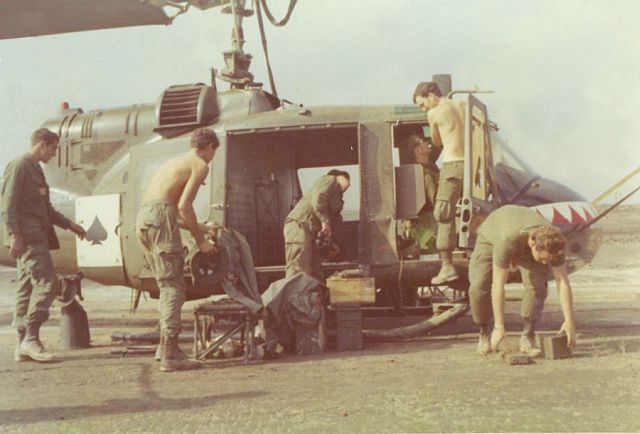
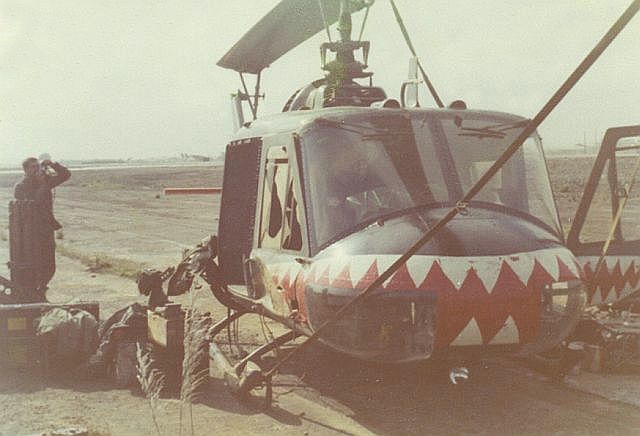
I was with the gun team that ran out of fuel in Laos
(See: "Shark Team Lost In Laos").
That didnít have to happen. We had relieved a gun team on station, that was supporting a massive
CA. Another gun team was to relieve us, so we could re-arm and refuel. Our relief never showed up.
We were well into the "20 minute warning" and the decision was to "get out" while we could. I donít
remember who was in the back with me as Door Gunner. I was flying as Crewchief with CPT
Ackerman as "flight lead."We crossed HWY 9 and I told CPT Ackerman, but he kept going. I had
many hours flying in Laos in í68, so I recognized some landmarks. We got into the mountains,
and it started "socking in" bad. I couldnít see anything out the windshield, so I stuck my head out
the door. We were almost at IFR (instrument flight rule), when I saw a dark wall right in front of us
coming up fast. I yelled to break left, and CPT Ackerman reacted. We barely missed flying right into
a large ridge. There was a clear valley at the bottom of the ridge, so we landed, positioning the
aircraft to use the armament if necessary. And then we set up a perimeter. After a while, we heard
what sounded like bird calls, but we didnít see any birds anywhere. After what seemed like hours,
we heard a Huey coming and we could see it coming through a pass, with a fuel bladder slung
under it. It landed, and a kid got out with a pump and hoses. We put a couple hundred pounds of
fuel in each aircraft. This kid from POL, started breaking the pump down, and we said "leave it."
He was scared that he would get in trouble for not bringing it back. He was told, if anyone had
any "bitches," to send them to us. It is a good thing he came, because I donít think anyone of us
knew anything about working the pump. American boots on the ground in Laos! Donít tell
anybody.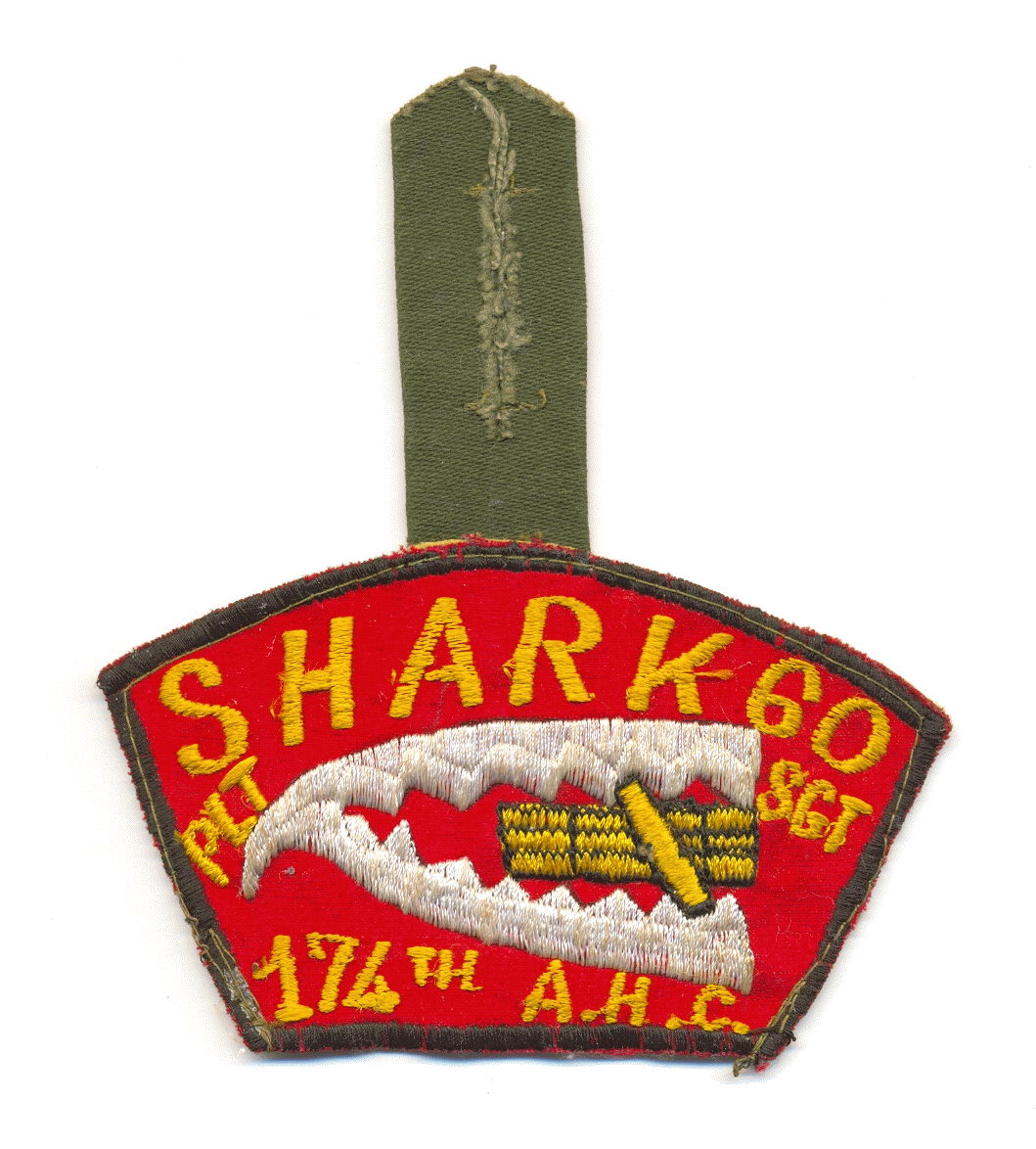
CPT Ackerman left shortly after that. Then Crew members Bud Vann and
Tom Taggart left. Bob Jansen and John Moore were both evacuated. Pilot Bruce Marshall
got seriously wounded, and " Sugar Bear" Gambrel DEROSíd. And that is just some that left. My
DEROS (date estimated return over seas) came and went. I didnít get orders, so I didnít say
anything. Just before Bruce got shot, we were to a point where we had enough people to crew
four Gunships, and one or two EM (and one Pilot) down for maintenance. I made it a point to
fly every other day, to give someone a break.
Maintenance, at that time, was almost too
good.
Shot up aircraft would come in at night, and be flyable the next morning. They were working around
the clock. I will always love and respect 1LT Butch Elliot and his entire "Crew" for the work they did. They were the 'Witchdoctor' Maintenance Platoon.
One time, we had a Gunship with some kind of armament problem. It had mini-guns & rocket
subsystem. Armament worked on whatever the problem was, and came to me to get a Pilot to test it.
I got Bruce Marshall and I got in the left seat. A couple of the armament people wanted to go along
for the ride, so they got in the back. They didnít have any weapons or flight helmets. We were only
going to find a free fire zone to test the system. We started out going towards the coast, but couldnít
get any clearance. We worked our way inland. We were approaching the "Rockpile" when we got a
radio call from a Grunt requesting assistance. We had found a place to test-fire. Some Grunts were
pinned down on the ridge near LZ Scotch. Bruce and I both forgot about our passengers. We rolled
in on the ridge, and little "sparkles" on the ridge opened up on us. I donít know how many passes
we made before the guns jammed. I believe Bruce emptied the rockets. We "hauled butt" to Vandy
to re arm, refuel and clear the guns. When we landed we remembered the "back-seaters." They
werenít in too good of shape. Finally, they "got it together" and helped us get ready to go back.
There were two more Sharks on the ground standing by, so as we went back out, we were told
we werenít needed. Actually, when Bruce was seriously wounded in February of Ď71, and was
on the hospital ship, the Grunt radio operator (that had called us in) was in the bunk over him!
Small world.
I went to Saigon to pick up a rebuilt Charlie model (UH-1C). I was going
as the TI (training instructor). The Company couldn't afford to send a TI, because of all the workload
of patching up battle damage. I donít remember who went with me to fly it back. It was already
planned that we would spend the night in Saigon. I found some little "nit picky" thing that had
to be fixed before we took it back, so I got my only R&R in three years! It was a great Gunship,
and I decided to "crew it" myself. Hell, I didnít have anyone else! I had 19 round rocket pods put
on it. I didnít want anything to malfunction, and every time it left the ground, I was on it (until I left).
A month later, it was as beat up as the rest of the Gunships, and looked like a speckled puppy
with all the patches.
Out of the eight Shark Gunships that we went to Lam Son 719
with, the Company only took three of them home. During Lam Son, some Shark Crew Members
were shot up, but no one killed. The Slicks Crews werenít so fortunate. At this time, MAJ Searcy
left and MAJ Dale Spratt took over the Unit. In all my time in the military, Spratt was the finest
Commander I ever had (and I had some good ones). Those UH-1C Gunships were "out-classed"
in every way, except for the guts of the people that flew them. They were too slow, and heavy, to
keep up with the Slicks. Their time on station left a lot to be desired. For example: We would take
off from Khe Sanh and fly to Lang Vei to "top off" just to get to the LZ or PZ. Then only a couple of
passes before we ran out of fuel. I donít know how many times I saw a Platoon or Company size
unit in the open, but we couldnít engage because of fuel and armament. Communication was a
major drawback. I could pinpoint enemy mortars firing on the LZ or PZs, but we couldnít suppress
them, because we couldnít communicate to "fix" on the friendly position. We were all getting
totally exhausted and stressed out. We all lived with constant fear and frustration.
The
day after SFC Foster shot himself (It was classified as suicide March 1971. I had found his body),
MAJ Spratt told me, in no uncertain terms, it was "time for me to go". It was the hardest thing I ever
did, but he told me it was "over." I turned my gear in, and left Quang Tri with little more than what I
was wearing. I felt like I was deserting, but I was almost 30 days past my DEROS. When I got to
Chu Lai, I saw one of the Warlord (117th AHC) birds on the ramp. For some reason, I asked where
they were going and the pilot said Duc Pho. I still had some gear at Duc Pho, so I asked for a ride.
On the way, somewhere near Quang Ngai, we were diverted to make an emergency re supply to
a Grunt unit. It was supposed to "hot." Needless to say, I wasnít impressed. A few rounds of AK
fire and it was "hot?!?"
When I got to Duc Pho, the hootch maids had taken over the
Senior NCO hootch. They were honestly glad to see me, and asked where everybody was. The
next morning, I left my gear and caught a ride back to Chu Lai. It was "time for me to go". I walked
into Personnel, and when they found out who I was, I was Ďhand carriedí through. The NCOIC
took my flight records, and that was the last I heard of them. He asked what medals I wanted,
the ARCOM or BRONZE STAR. I told him I didnít give a shit about medals, and if I could choose
for the medals, they werenít worth much anyway. In a couple hours I was on a priority flight to
Cam Ranh Bay. I was pushed to the front of the line, and on the next flight to the States. I didnít
have time to get the Quang Tri dirt off before I was in FT. Lewis, and then on my way to Fort
Bragg. The home of the Airborne.
When I left the 174th in March 71, I was
assigned to A Co
82nd Avn. Bn. as Maintenance Platoon Sgt. at Ft. Bragg. I was still on flight status and also started
"jumping" again. Most of the parachute jumps were what we called "Hollywood jumps" out of UH-1s.
I enjoyed that as much as flying. In early 1972 the Bn Commander asked if I would volunteer to go
back to Vietnam TDY (temporary duty) with a detachment from B Co. 82 Avn. They had UH-1M
models with SS 11 missiles, and they wanted to test them against the NVA T54 tank. I would be
a TI and wouldn't be expected to fly any missions. I didn't hesitate saying, no thank you! He could
order me to go, but I would not volunteer. There was no way I could send my people in "harms way"
without going myself. He said he understood, and someone else went instead.
A Co
had UH-1H models and they were fairly new. They were all nice and clean with no patches! And
B Co had OH- 58s and UH-1M models. Everything was like new. I actually got a little "stick time" in
the M model. It was a whole different world from the C models (lots of power to spare!). I sometimes
wonder why the C models weren't converted years before. It would have made a significant
difference, especially during Lam Son 719. We could have kept up with the slicks, and given them
the Gunship fire support that they needed so badly. Lives would have been saved.
In 1974 I
was promoted to First Sgt. and transferred to Headquarters Company. This was not a good
assignment for someone who had never been in a Headquarters Company. There was a daily
battle with the Staff Sections. I still had my "Detail" that had to be done, and it was like pulling
teeth to get the people to do them. I had an infantry Pathfinder Platoon in the company that was
constantly training, and the Staff Officers insisted I use them for Detail. I could not pick on just a
few for the good of the company. I no longer was on flight status, so I was on jump status full time.
Finally, I got tired of the constant battles with no support from the Company Commander or the
Sgt Major so I decided to retire. The Army was no fun anymore.
The 30th of June 1976,
I Retired. They planned a Retirement Ceremony for the Saturday morning before. I declined the
Ceremony. I didn't want the troops to have to stand in the hot sun and listen to a bunch of bullshit.
My last final gesture of defiance. The Army had my address, so they can mail it to me.
The first of July 1976, I put on another uniform. I went to work for Harnett County Sheriff's Dept.
(NC) to begin my second career. I was a "adrenaline junky," and this gave me what I needed. I worked
for Harnett County for two years, and decided to go back to school and get a Degree. I worked full
time in a galvanizing plant, and in school. After I graduated, my Wife suggested we move back to
Louisiana, so I could spend some time with my parents. That was one of many sacrifices she made
for me and my lifestyle. Her parents were from NC.
In 1980, we were back in La. and
I went to work as a line Deputy with Rapides Parish Sheriff's Dept. I was promoted quickly and
loved the work. There was enough excitement for me, and I had a lot of freedom. My wife passed
away from cancer in Feb 1998. She had wanted to go back to NC to spend her last days with the
family. After she passed away, life really had no meaning for me, until the people I worked with
(and had trained) made me "go on." They were constantly checking on me, and I realized I had a
big impact on their lives. They became my family. Eventually, I decided it was time to leave. I was
62 years old and still doing street work. I realized I was slowing down, and the "rush" didn't mean
so much anymore. I was going to move back to NC, and spend time with my kids and grandkids.
That didn't last. Their lifestyle was too different from mine.
met Lin, and we decided to
move to Florida. Now, we are enjoying our life here. I am working again at a "do nothing" job, but
it makes me feel very useful. Around 1999, Fred Thompson (the late) found me, and told me about
the 174th AHC Association and the annual Reunions in Ft Walton Beach. At the time, I wanted that
part of my life behind me, so I didn't follow up on it. When I moved to Mary Esther, Fl., I dug out the
correspondence I had gotten from Fred. I called Ted Saunders, and the next thing, I got a phone
call from Dale Spratt. I attended the 2002 Reunion, and it was like "old home week." It all came
flooding back. I only regret that I missed Fred. I did have a long phone conversation with him
on PJ Rothís cell phone from the Hotel. I am thankful I got that much. Fred Thompson had missed
the Reunion because of his health. He passed away one month later.
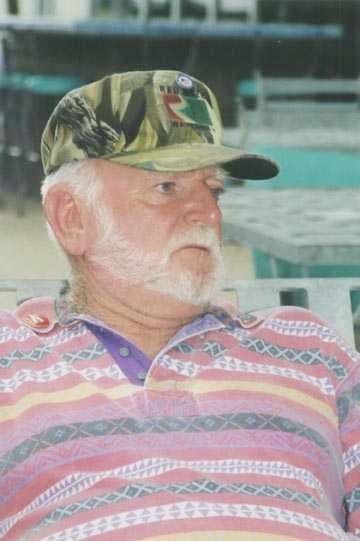
In my Military
Career I was in several Units. Some were good, and some not so good. None of them can compare
to the 174th Assault Helicopter Company. We all share a bond, because of having fought in the
same Company- under the same Flag. It is evident in the fellowship of the Annual Reunions. As long
as I live, I intend to make every Reunion and "get- togethers" that we have. God bless you all
and those who have gone before us to "Prepare the LZ."
